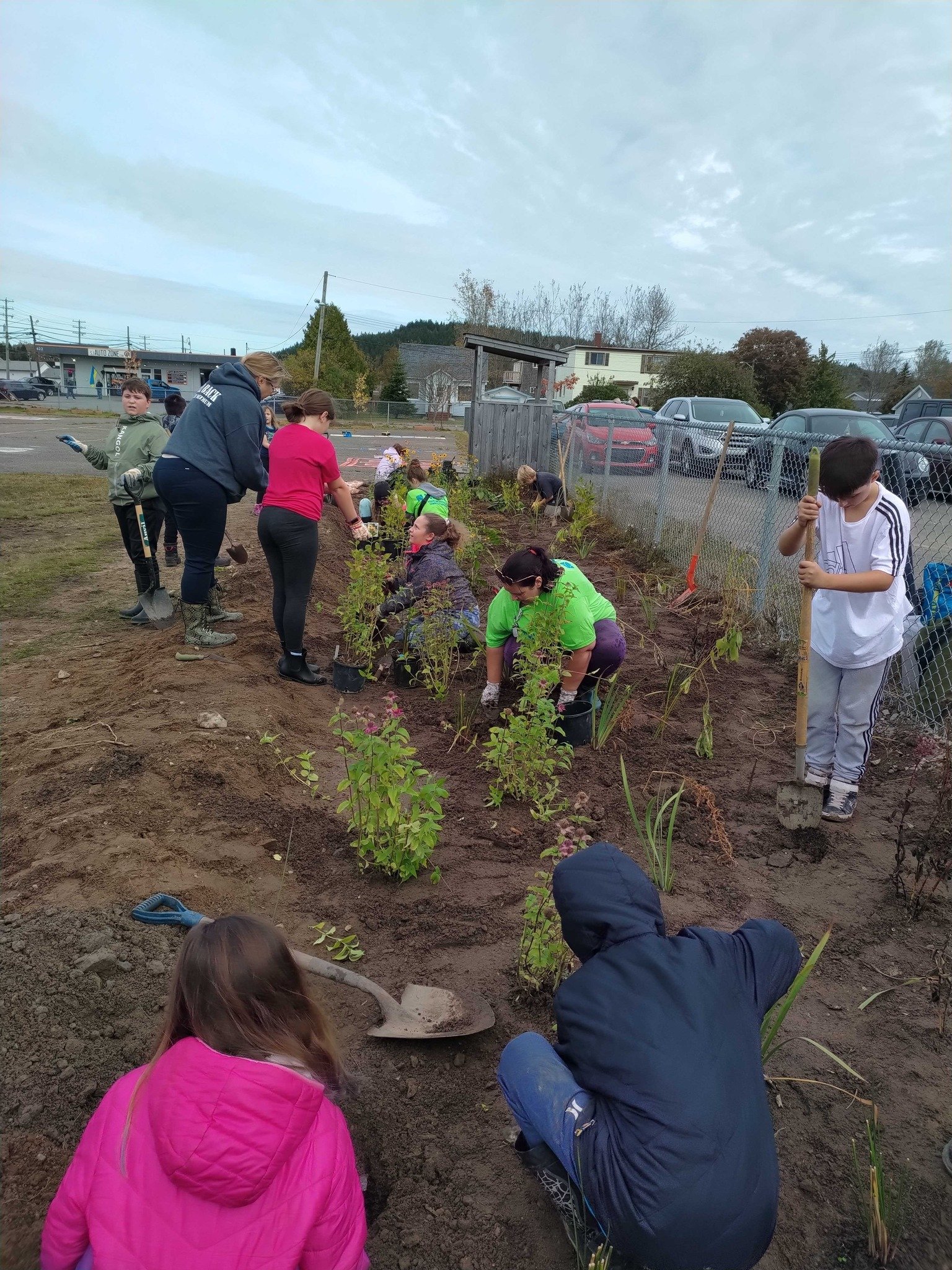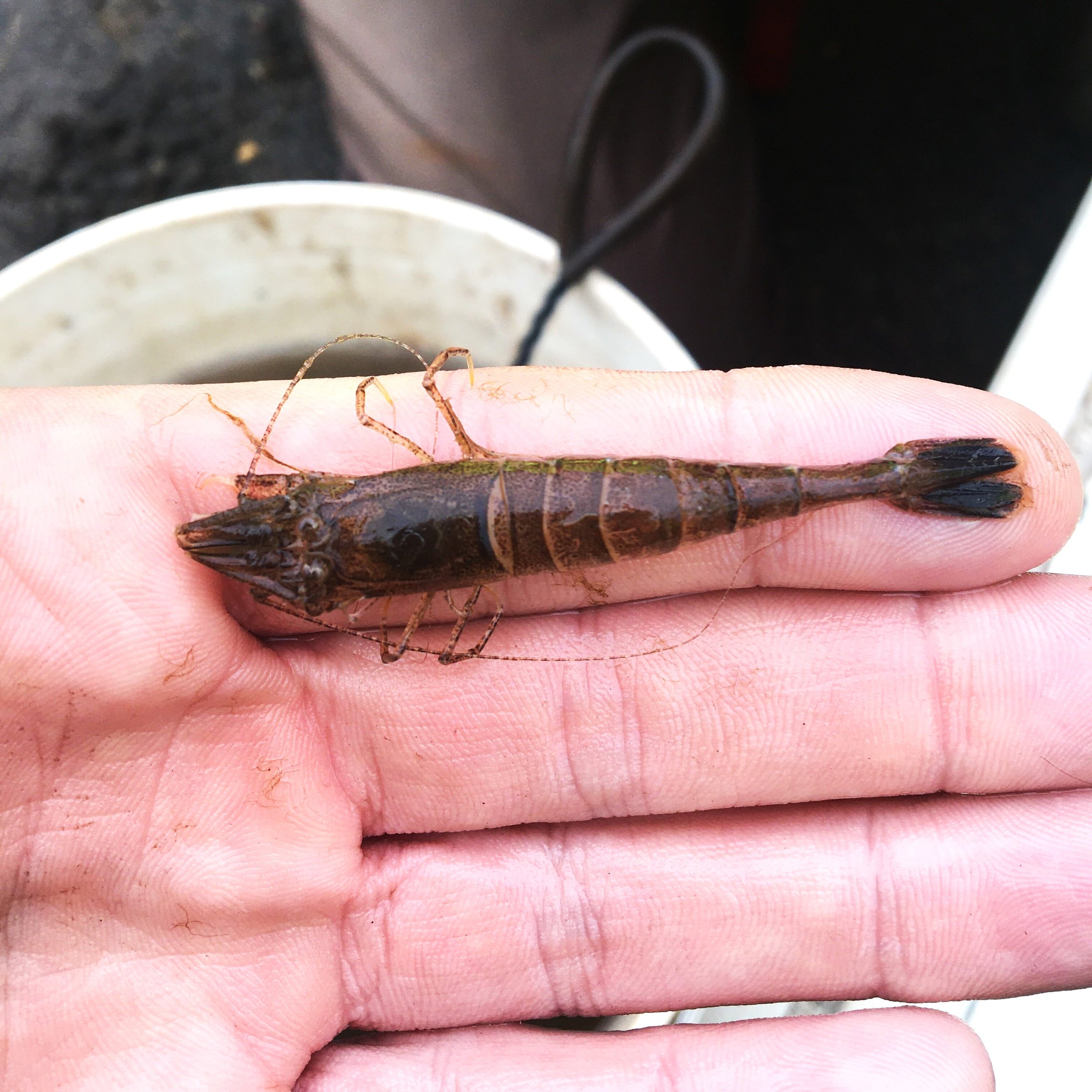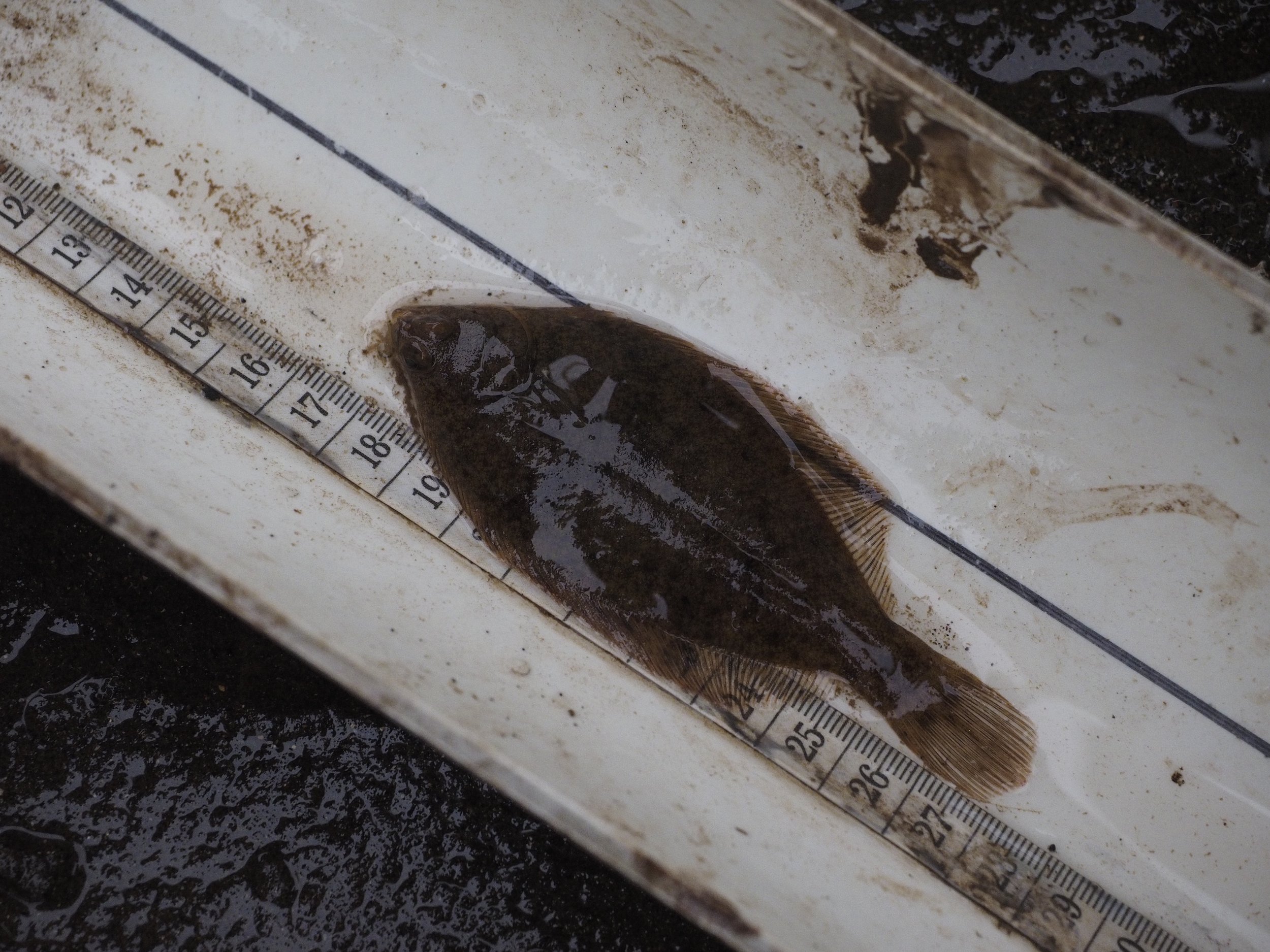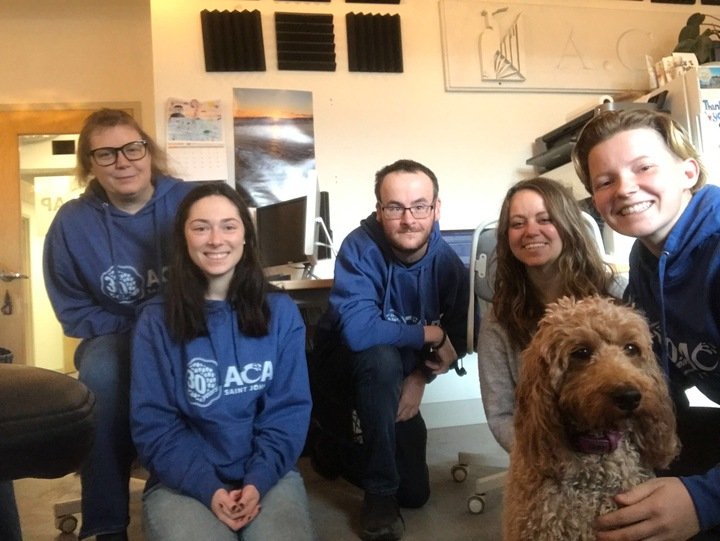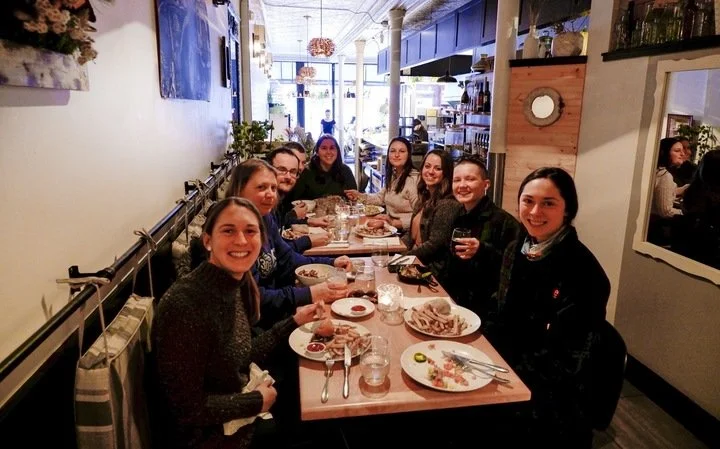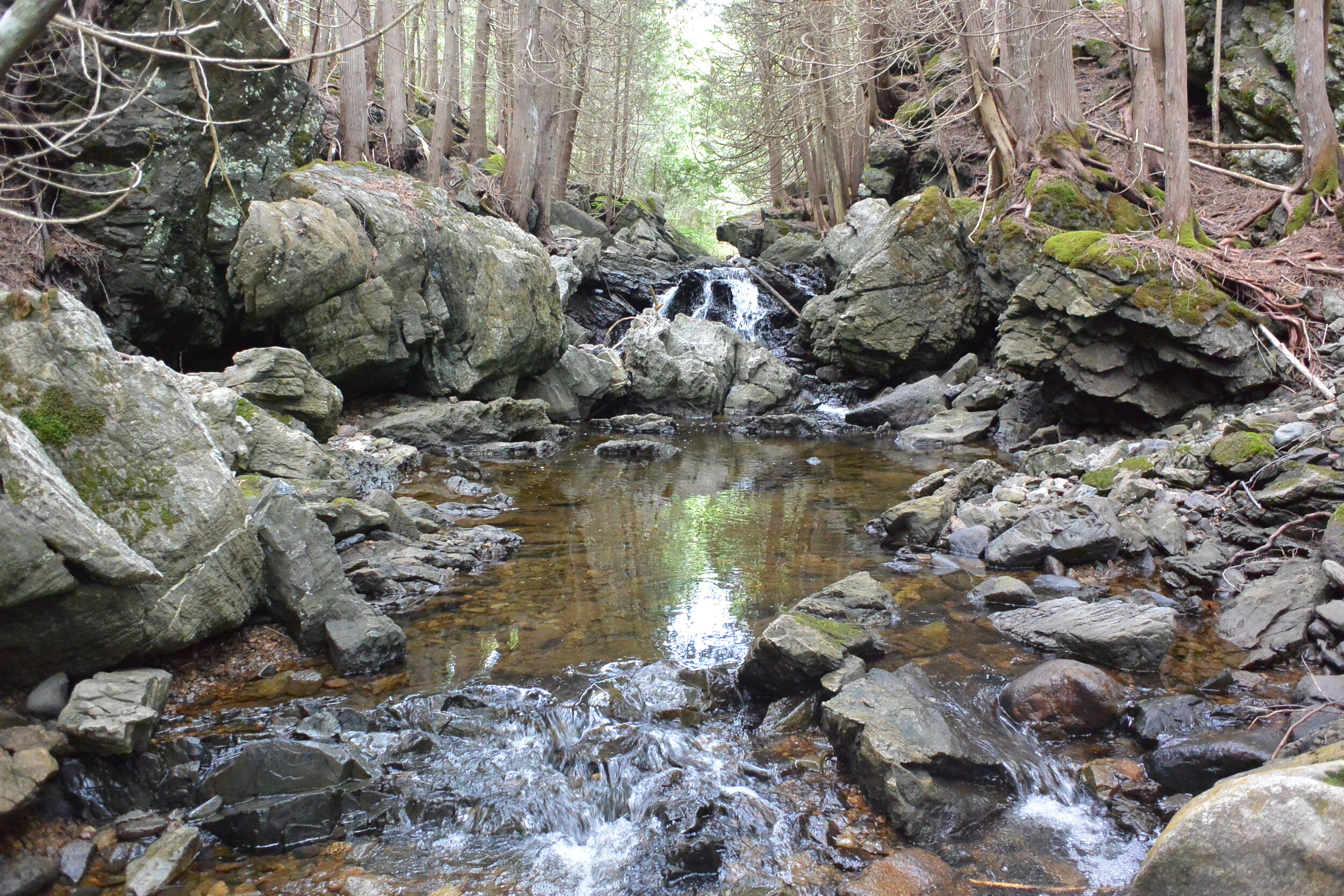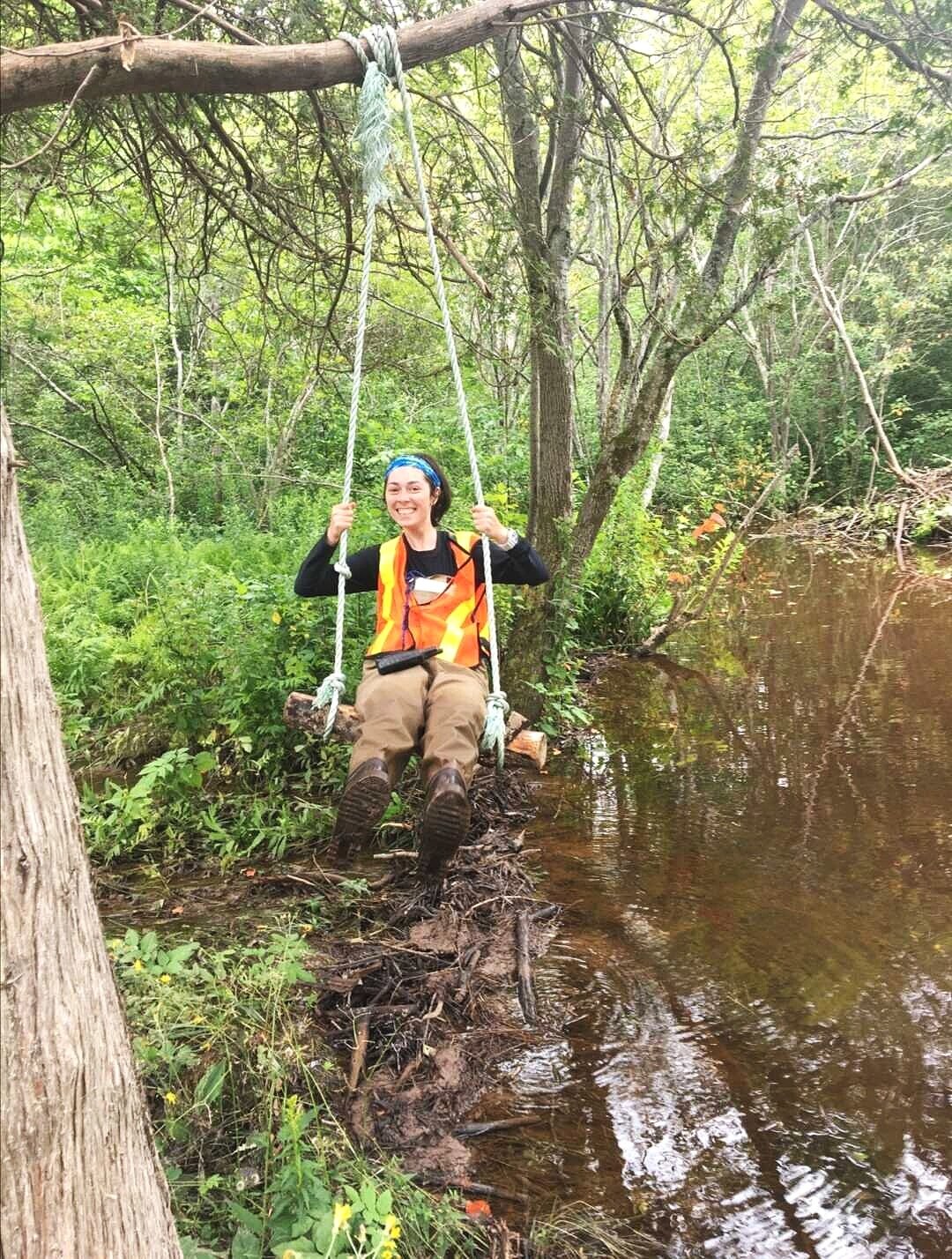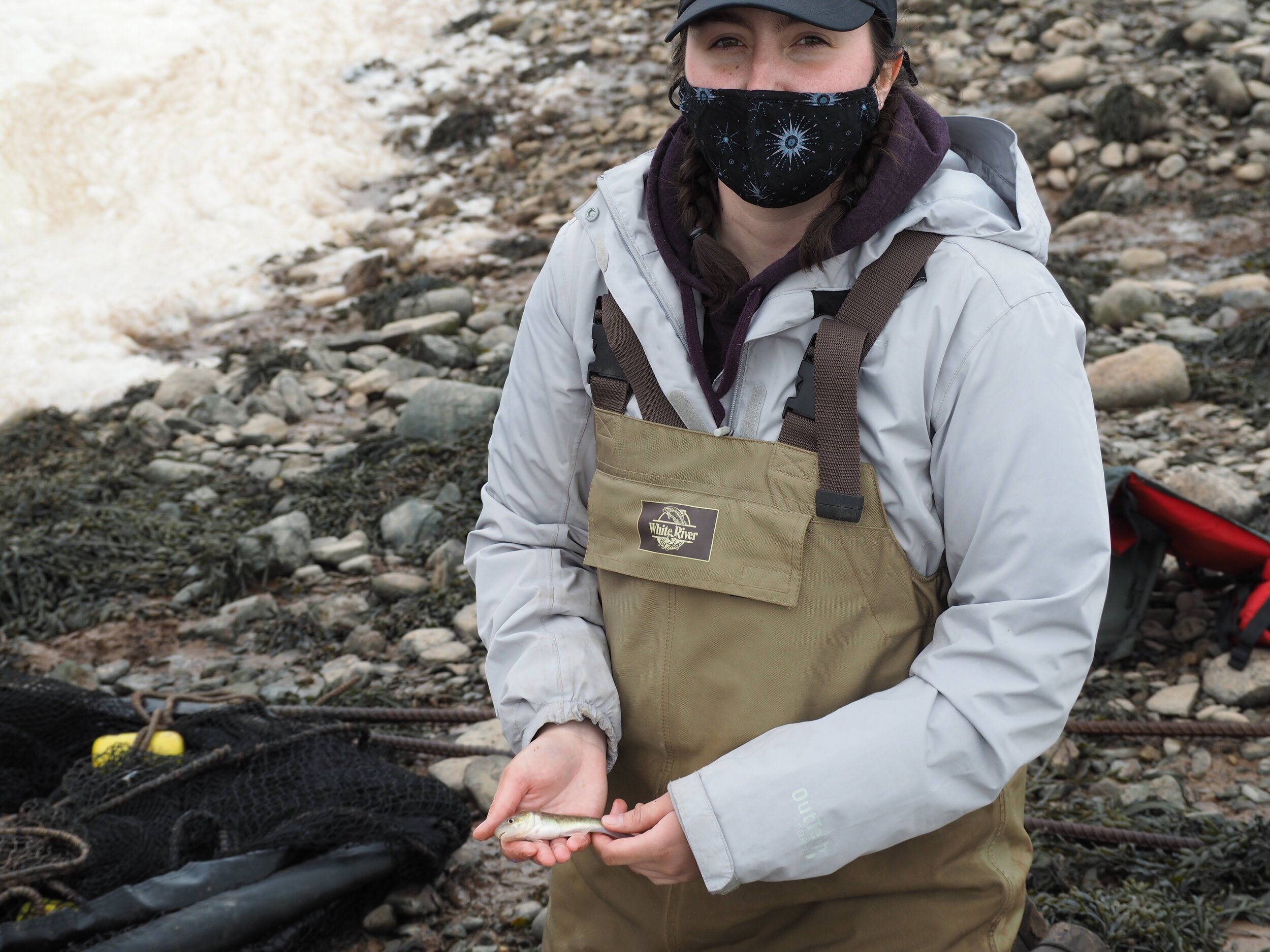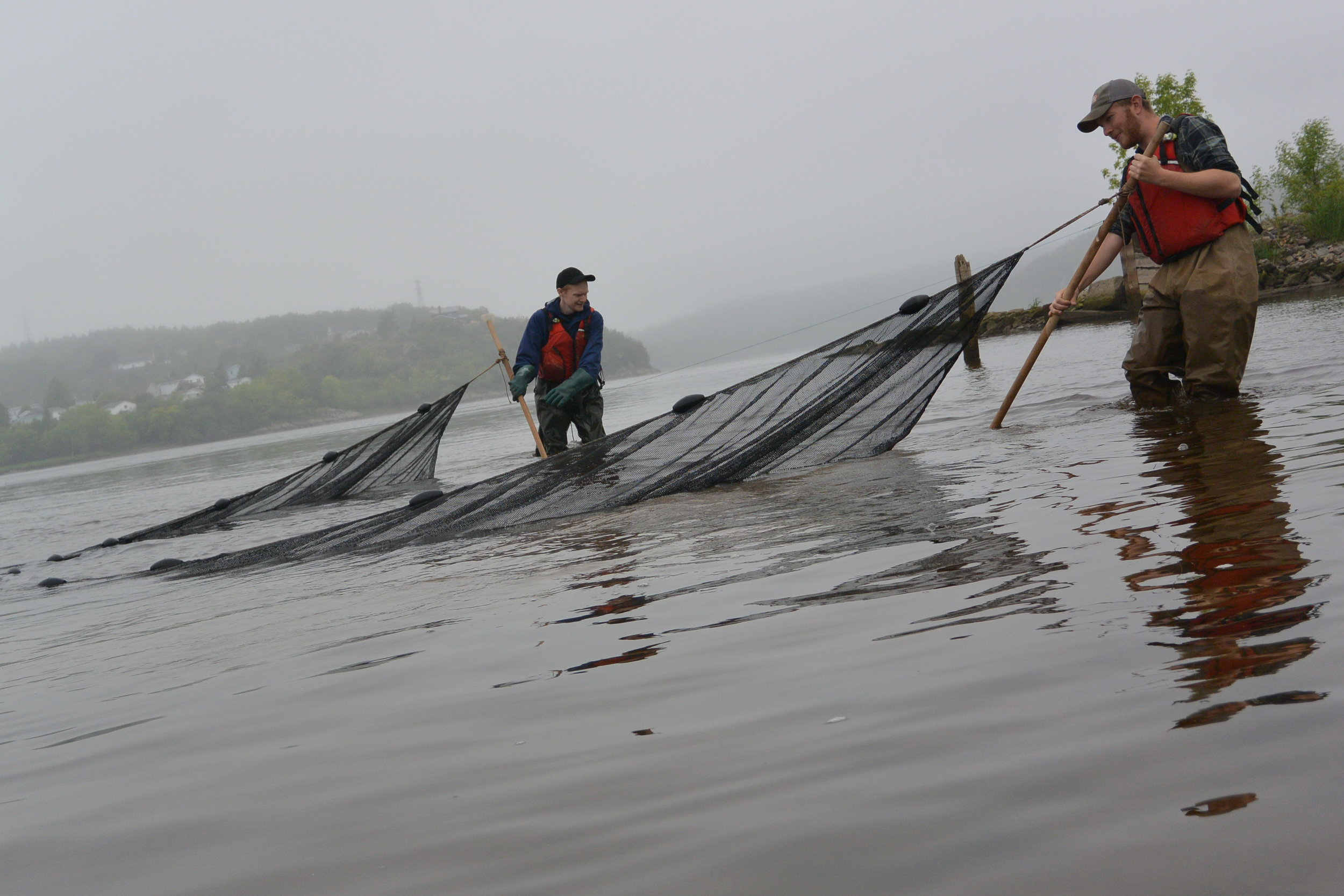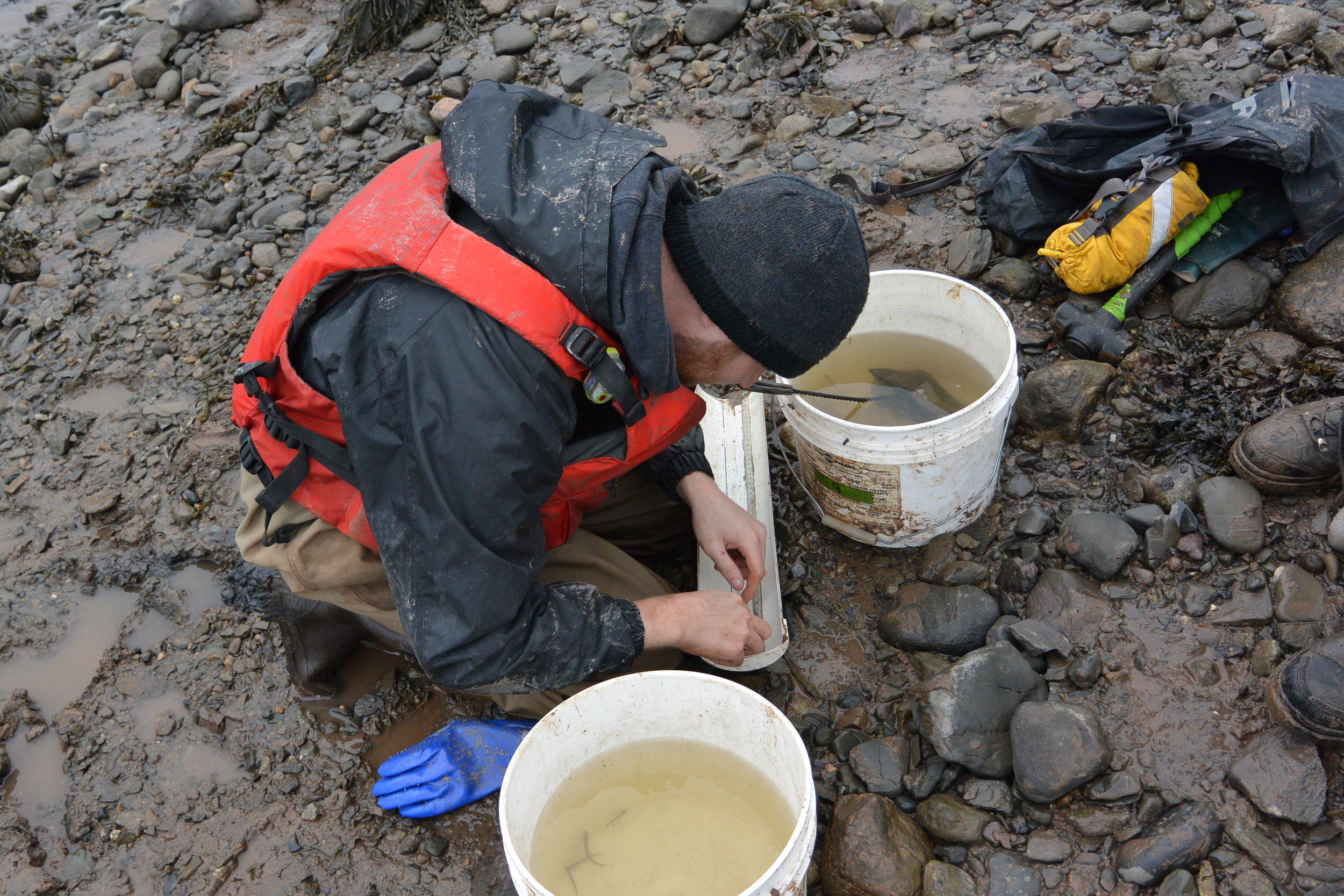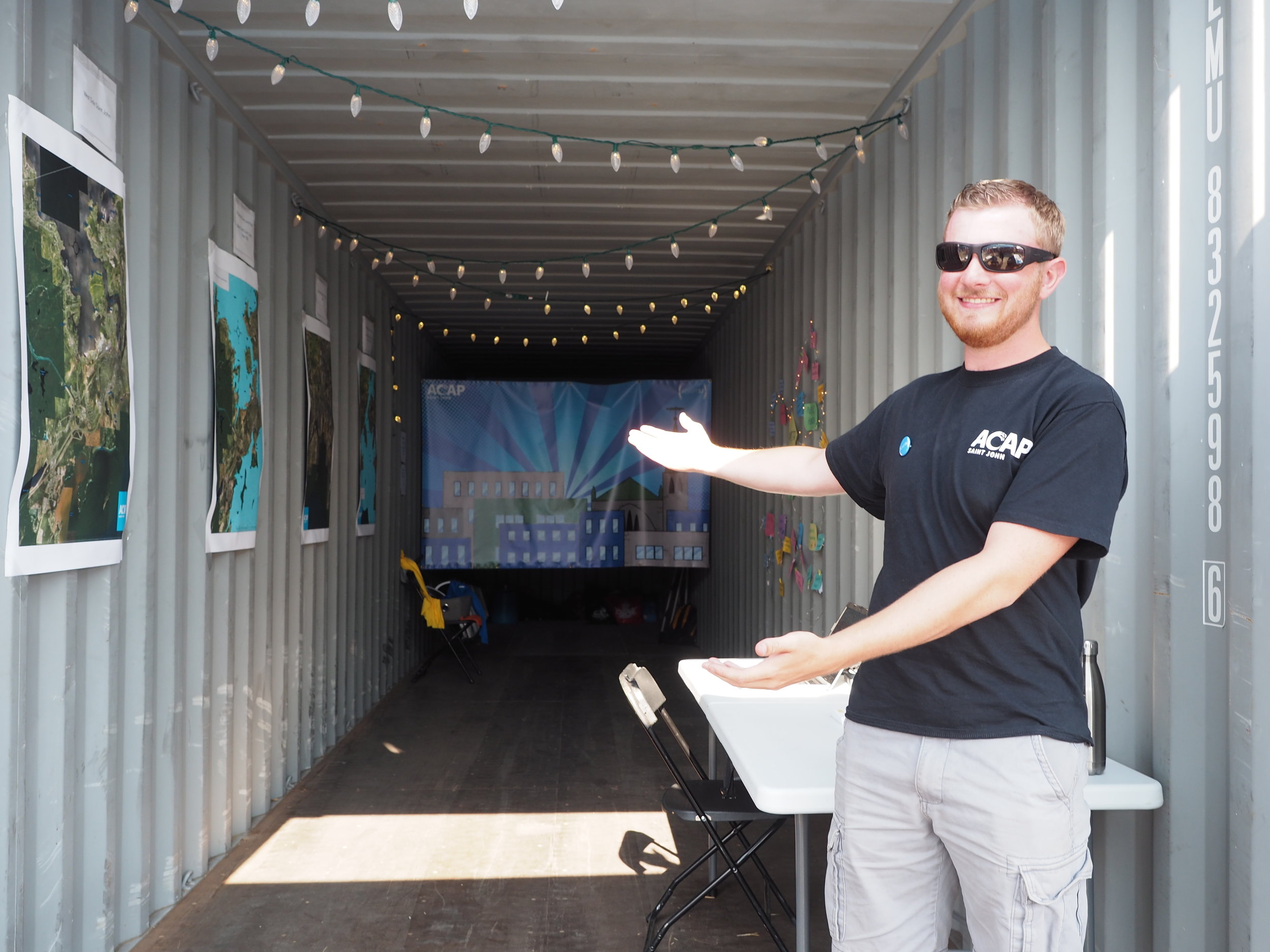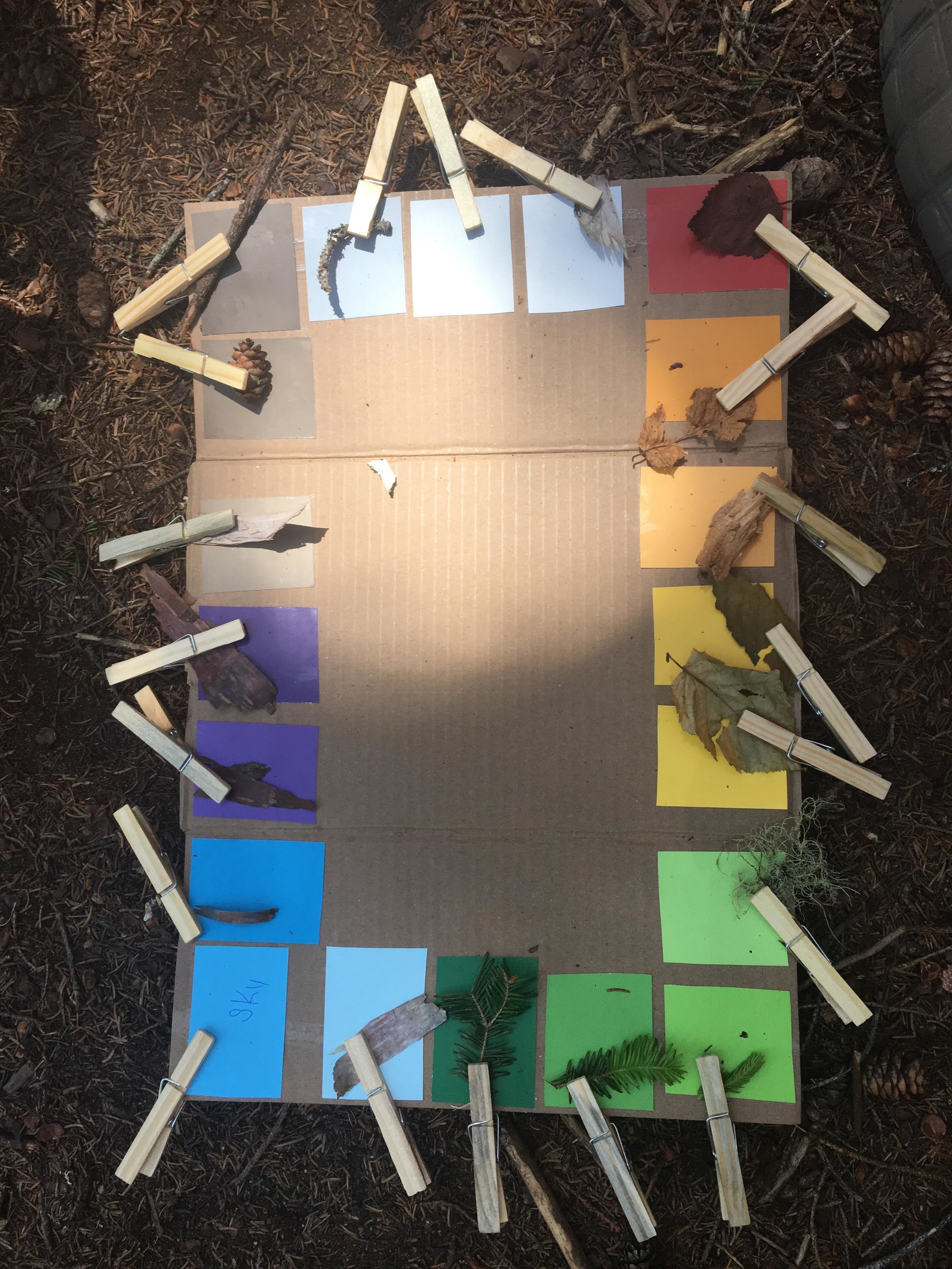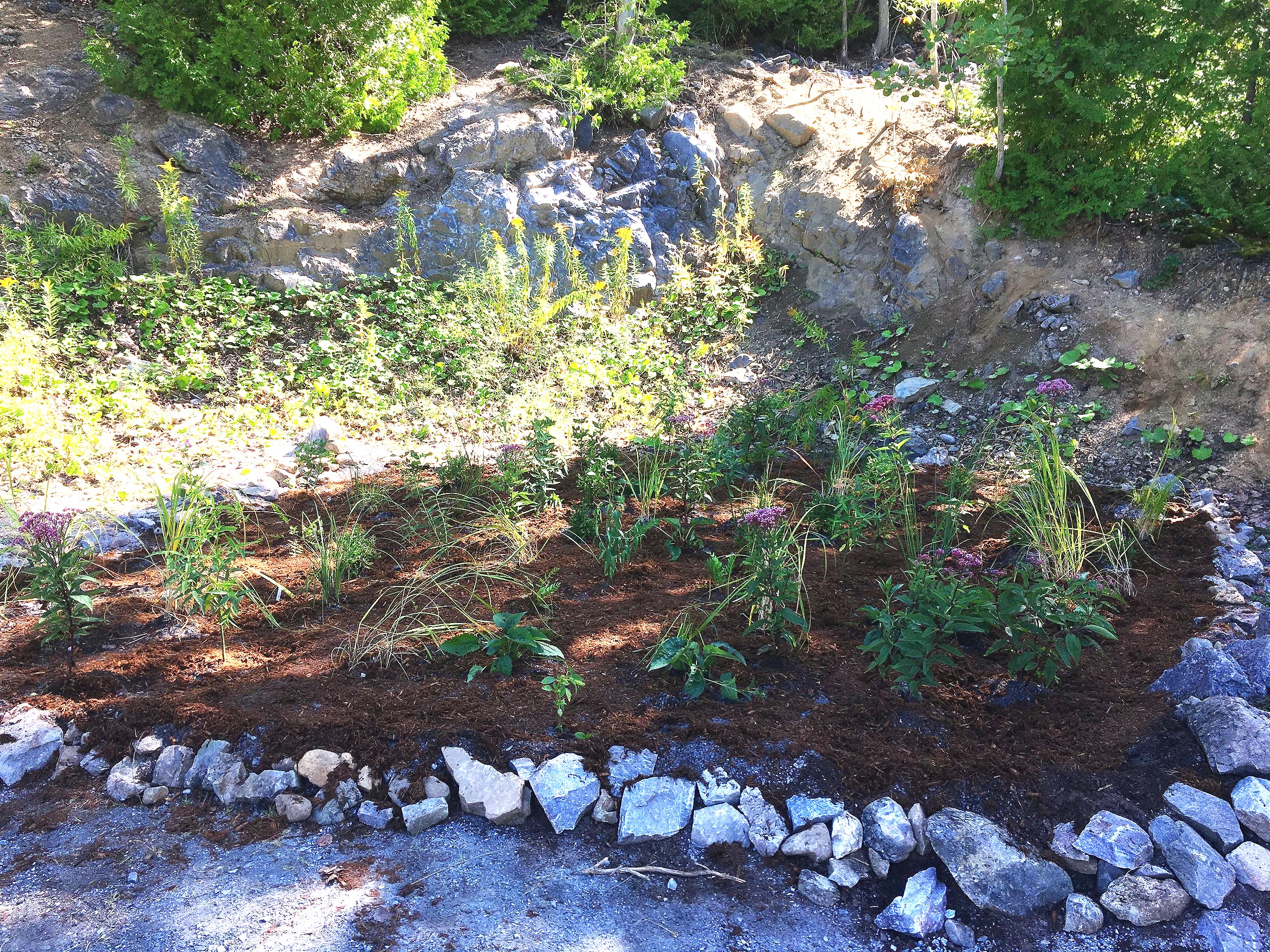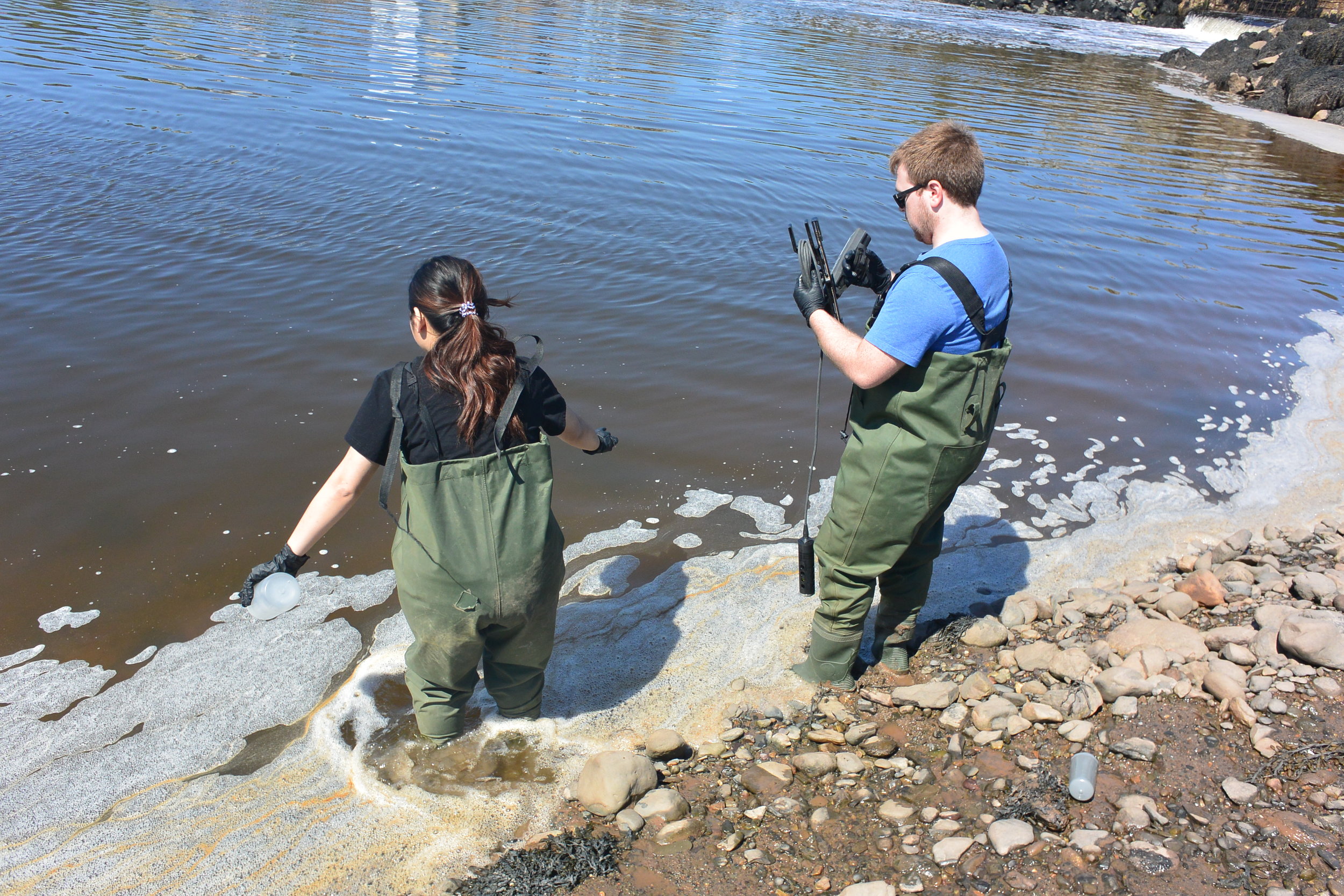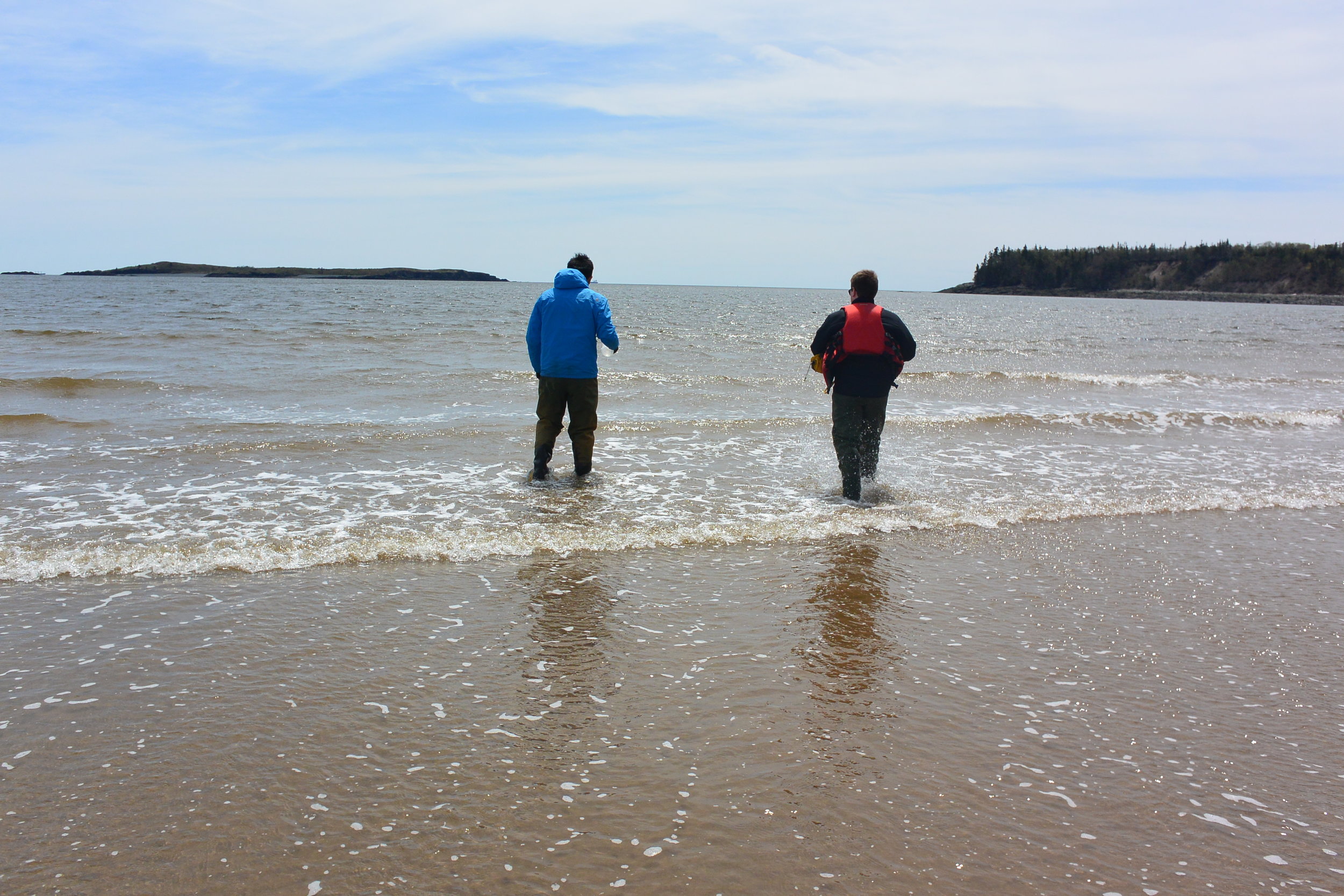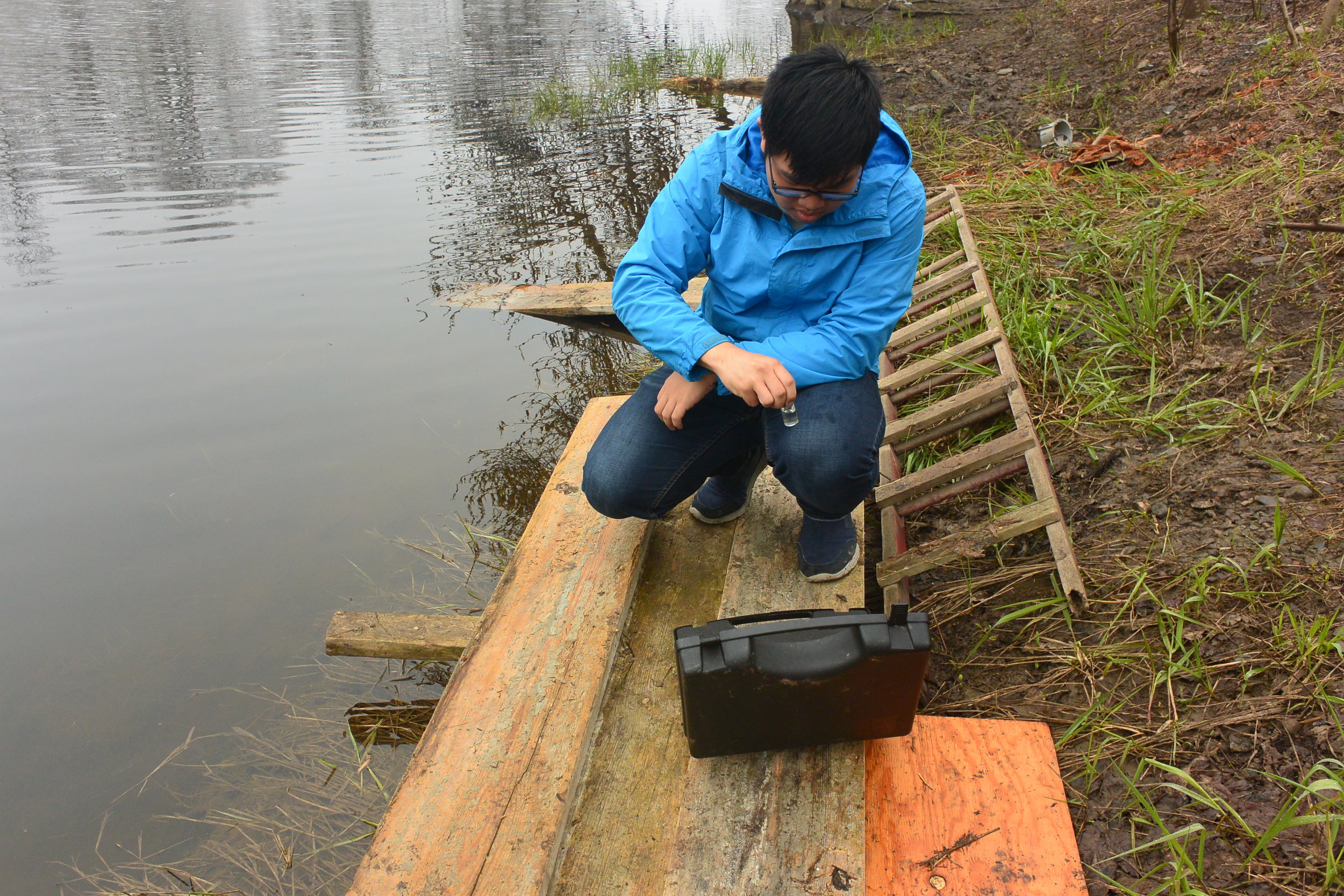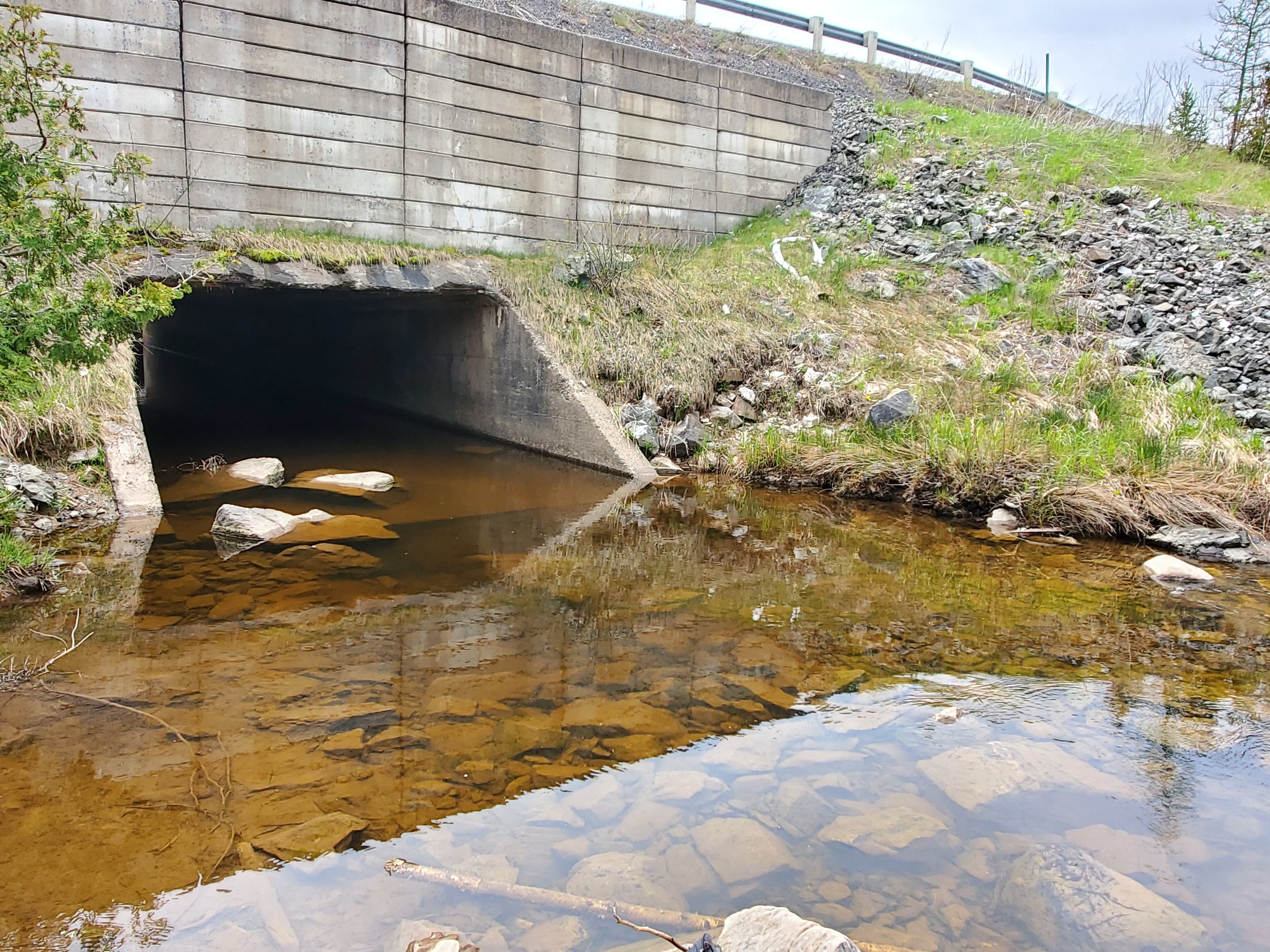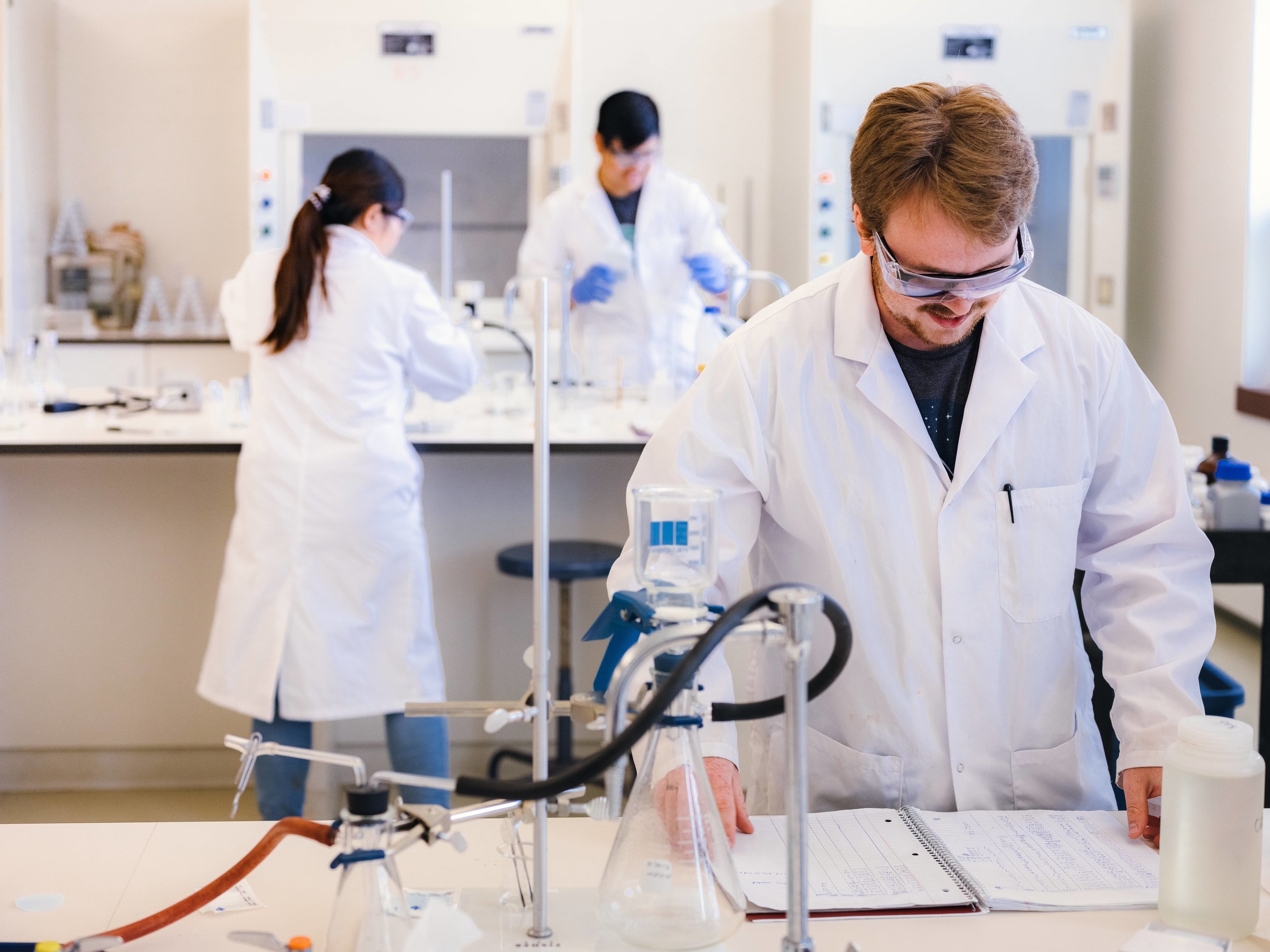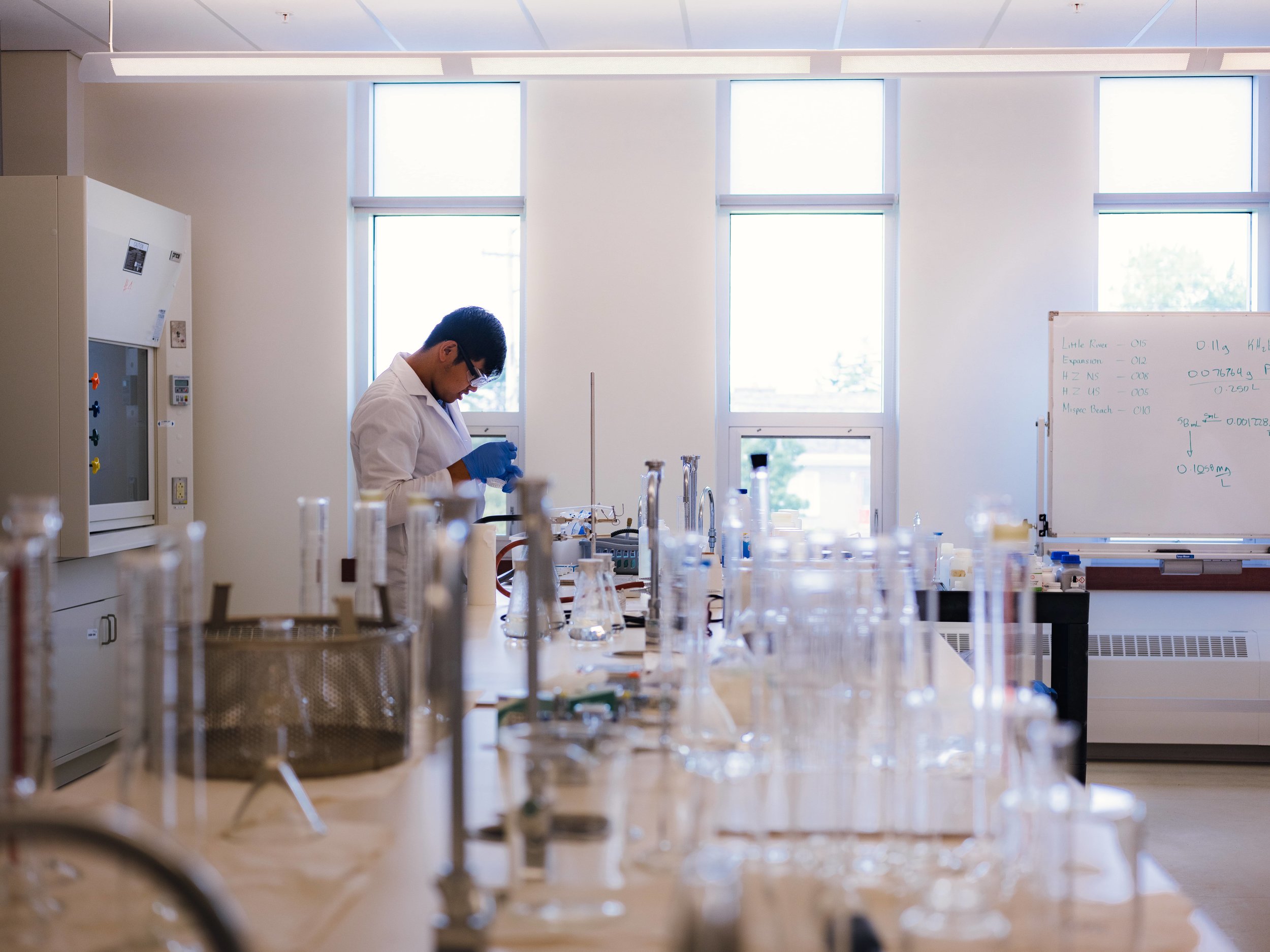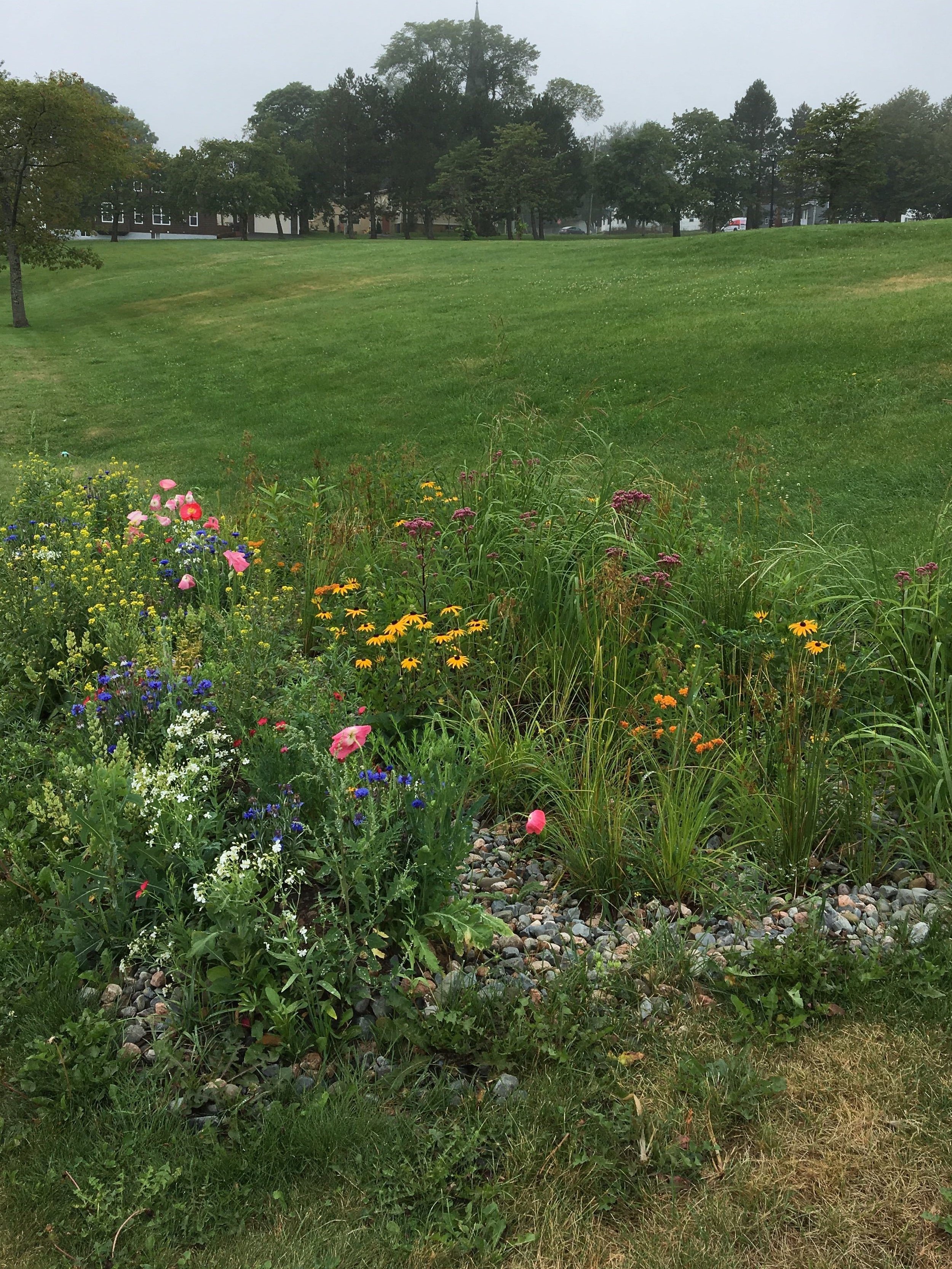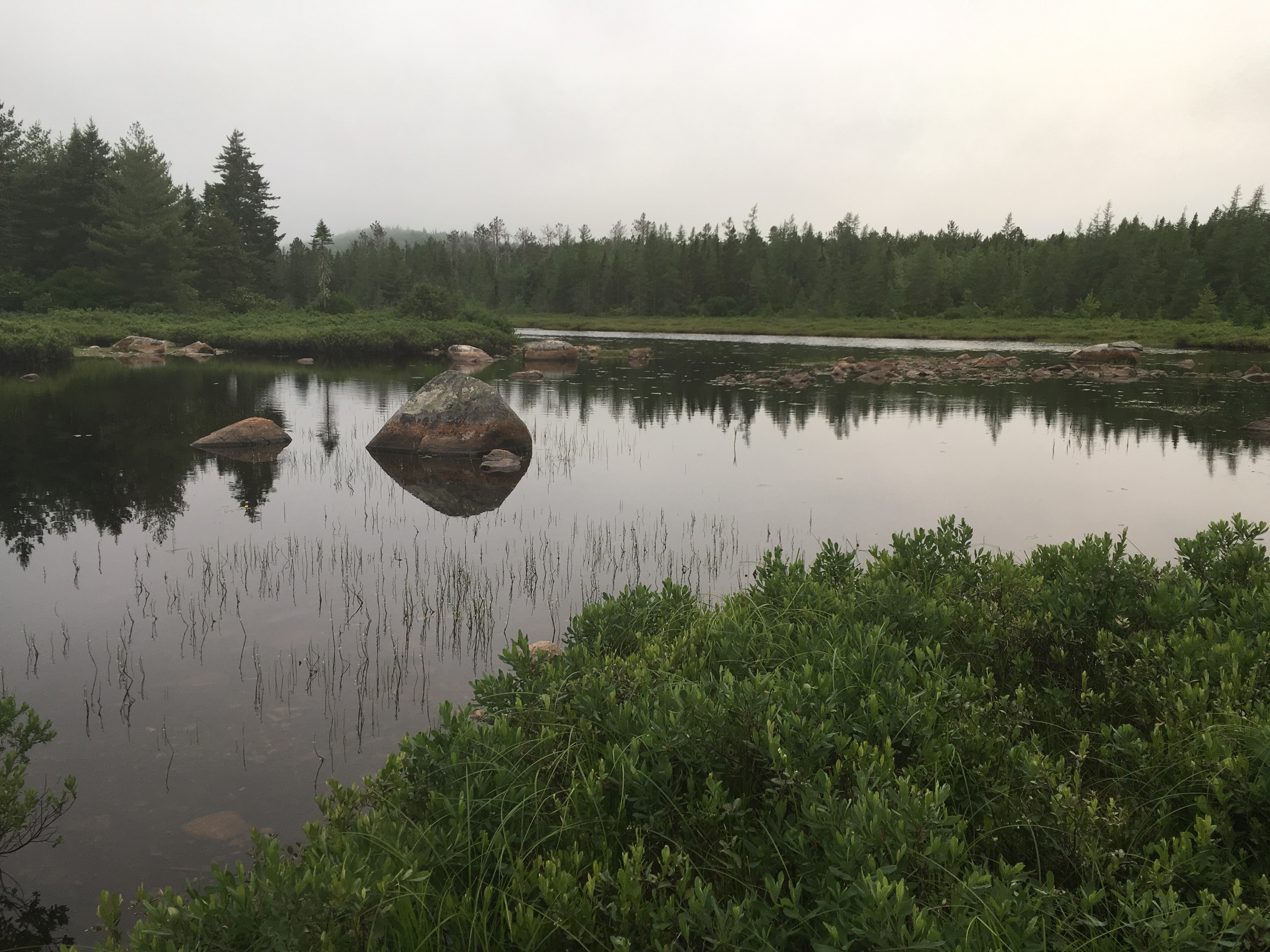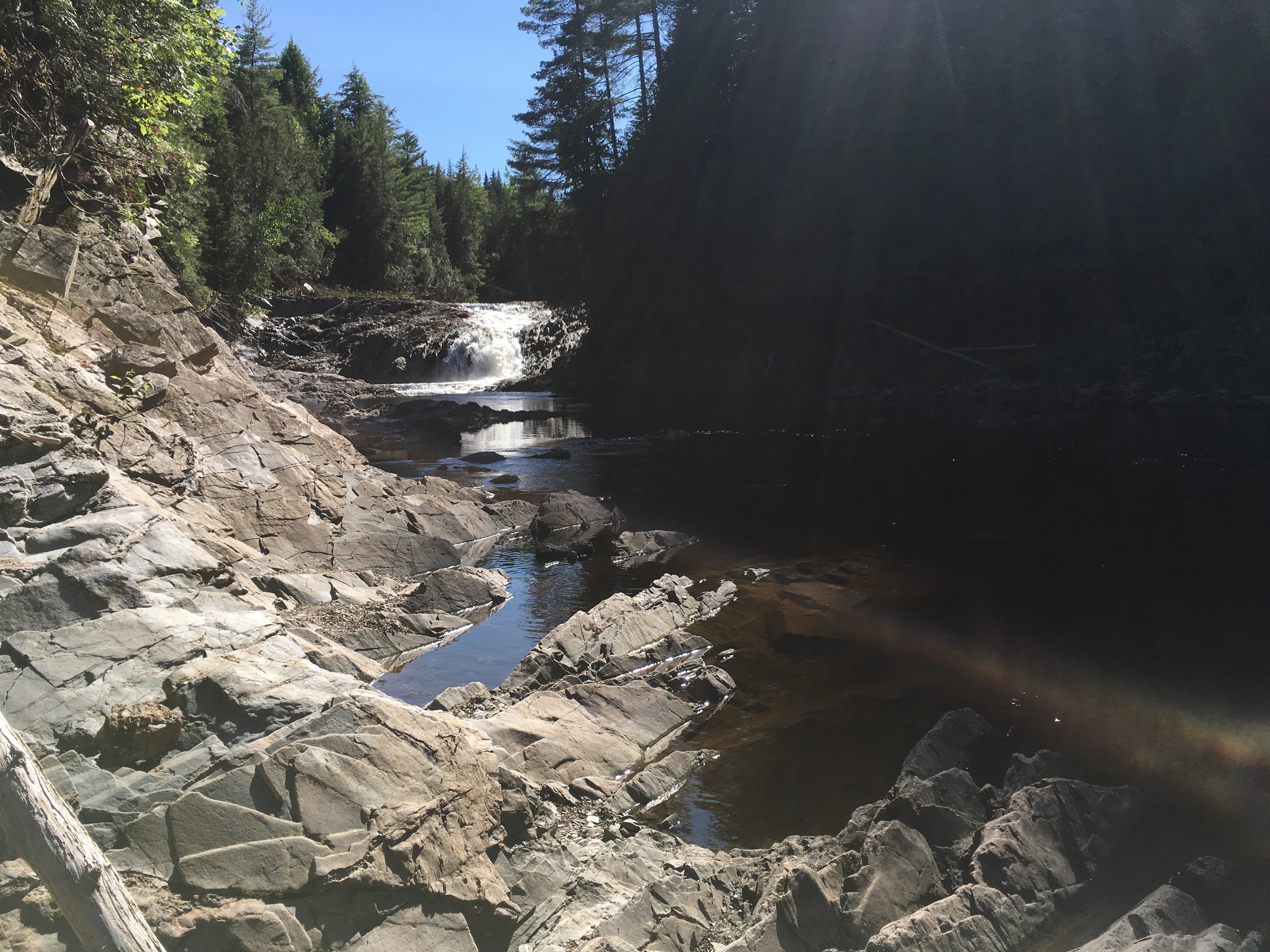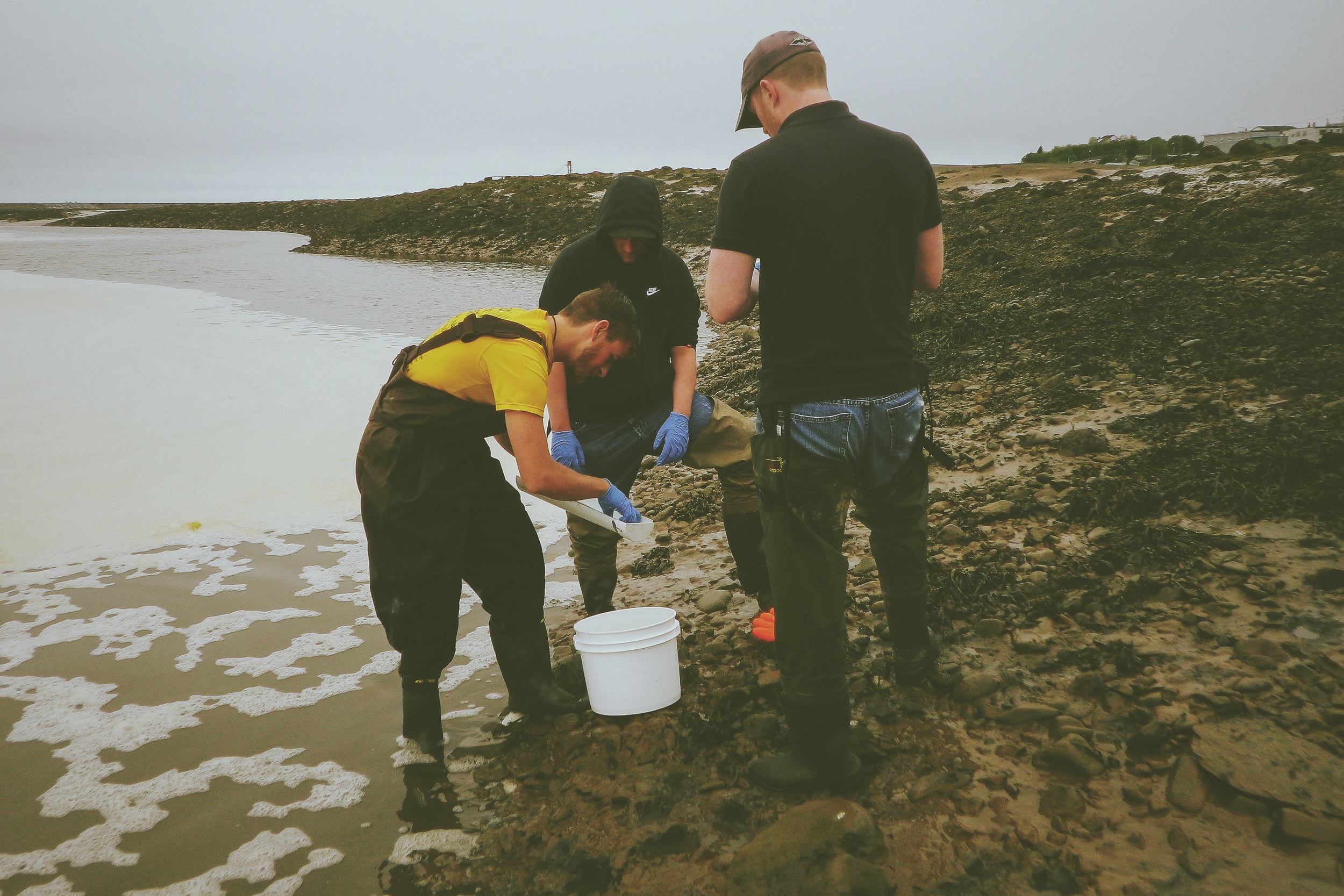
STAFF BLOG
My Internship with ACAP Saint John: Giving Back to the Community
From August 2022 to March 2023, I held the climate change communications intern position at ACAP Saint John. This has been a professional and personal experience for me since my family has roots in Rothesay, although most of them now live in Quebec. Being back in Saint John and working at ACAP brings back many memories from my childhood of this area. During the internship, I have had the opportunity to take part in many different activities including native tree plantings and maintenance, gardening, community cleanups, Saint John Harbour monitoring (of water quality, fish, and seals.), and classroom education.
There are two specific projects I have participated in including the Glen Falls School green infrastructure (GI) project and a climate change education project with local high schools. These projects were heavily focused on community engagement and communication. The Glen Falls School GI project consisted of creating a rain garden with the help of over 100 elementary school students. We also dug two infiltration trenches to help the schoolyard soak up rainwater, allowing the ground to dry up faster so the students can play outside. The main reason why this project was completed is because the school is situated on a natural floodplain. During the project, I was involved in coordinating the NBCC (New Brunswick Community College) students who came and helped us dig the infiltration trenches. Other ACAP staff were working to oversee tree planting and helping the younger students plant the rain garden. I was happy to be involved in this project and learn more about GI in the community.
Presenting to Sam-De-Cham students.
The climate change education project in high schools was part of a bigger project to foster climate change leadership among youth in local high schools. During the project, I was able to meet student-led green or environmental teams from Simonds High School, Harbour View Highschool, and the Centre Scolaire Samuel-de-Champlain. The two main reasons I was meeting with these students were to provide feedback on the ongoing projects they are interested in, and to motivate them to implement more environmental and climate action projects in their schools. During my internship I also took part in other educational activities organized by different members of ACAP Saint John including outdoor education activities with elementary schools, and community presentations. This experience has allowed me to coordinate presentation dates with multiple schools and gain confidence when presenting and working with youth and the community in general.
The Saint John Harbour monitoring project that I have taken part in during my internship was not part of my projects but all staff were able to chip in and help out. What I really enjoyed about this experience was learning more about the marine life around Saint John. I also enjoyed getting the opportunity to see live fish from the Bay of Fundy up close and to observe seals around the coastline of the city. If I was asked what species I enjoyed the most, I think I would answer the sand shrimps and the flounders.
In December 2022, I began working on a report on the ways that climate change is framed in the news. I really enjoyed researching this topic and writing the report. Overall, it is possible to see that news stories are starting to discuss climate change and its impact on the environment more. This can especially be seen within the conservative news stories that are slowly starting to realize the importance of covering the issue.
Although there are still many conservative news agencies that do not realize how important conversations around climate change are. Another important issue uncovered during the development of this report was that a lot of media confuse the terms climate change and global warming. This mix-up is one of the main reasons why so many people still do not want to accept that humans are having a negative impact on the environment and that we need to change our way of life. The report can be accessed at the link below. It has been a good experience and a reminder to be careful when reading and interpreting climate change news.
One of the things that I have been the most grateful for during this internship (in addition to the work experience gained) would be the chance to rediscover the beautiful Saint John region. Many places I have visited during work hours reminded me of my summer trips with my family when I was younger. I am also grateful for having had the chance to work with such a fantastic group of people.
In the Streams, Living the Dream
I have been admiring ACAP for years now; their work inspired me to pursue the Environmental Technology program at NBCC Miramichi. As a summer student at ACAP, I felt as though I was on an adventure rather than working. At the beginning of my placement, I spent most of my time conducting stream assessments within the main stems of Henderson Brook and Spruce Lake, as well as the entire Mill Creek watershed. Heavy bug and bushwhacking led us to seldom visited areas that were inexplicably beautiful. We found many treasures including multiple waterfalls, fascinating bedrock, a cave, a swing beside a beaver dam, and two Barred owls in the same tree!
The purpose of the assessments was to locate any blockages that may interfere with fish migration. We were able to breech one of the largest blockages that we came across; it was some of the hardest labour I have ever done but nothing was more enjoyable or satisfying than removing the jam and watching the water flow.
I was also able to assist with numerous shoreline assessments as part of a project that aims to monitor coastal erosion of vulnerable areas in Saint John. Through measuring and observing erosion, vegetation, soil type, as well as foreshore and backshore type, we were able to determine the stability of the area’s shoreline. This will allow ACAP to build awareness of this very real problem so that we can be more prepared as a community as we plan for prevention and adaptation. We learned a lot during our assessments of the shorelines in areas such as Red Head, Anthony’s Cove, and Bayshore Beach; some of the most valuable information was shared with us by residents experiencing erosion firsthand.
Maggie Brogan, Field Technician, determining slope of erosion at Bayshore Beach.
It was a privilege to be part of ACAP and to work with such a knowledgeable team who are so willing to share their experience and expertise. The more I have learned, the more aware I have become of the interconnectedness of everything around me. They say that if you do what you love, you will never work a day in your life; I have very much found this to be true. I am so grateful for this opportunity, and I look forward to seeing the projects and reports come to life, and the exciting work that is in store for the ACAP team.
Shayelin Braydon
My Practicum at ACAP
As an Environmental Technology Student at NBCC we have the opportunity in our second year to do a work practicum. I was lucky to be able to complete my practicum at ACAP Saint John! I wanted to go somewhere I would get a variety of experiences. I definitely chose the right place!
I have followed ACAP Saint John on social media for quite a while now and they always seemed to be doing really awesome things like education and outreach at schools, organizing beach cleanups, making rain gardens, seal monitoring, fishing in the harbour and much more! I was happy to be able to participate in most of these activities.
I got to help with the weeding of the rain gardens, set up rain barrels, and put signs up at multiple locations around Saint John. I tagged along while looking for tree planting sites, helped out for fishing week, went seal monitoring, and went to schools to engage with the students through outdoor activities.
My favorite week was fishing week! I got to go fishing at four different sites in Saint John. I got to use a couple of different types of nets to catch fish and shrimp. We identified each species, measured them, then released them back into the water. The coolest fish I saw was a huge winter flounder that measured 350 mm long!
I also really enjoyed the education and outreach that ACAP did with schools over the past five weeks. I was able to go to a few different schools, one of which took me to Deer Island. Another project I was happy to take part of was nutrient sampling. We spent a day going to various sites along the Saint John River and its tributaries.
Through all these experiences I got to see parts of Saint John that I have never been before. Being from the Norton area I did not have any experience working along the coast and through this practicum I was able to gain this incredible experience.
Thank you so much to the ACAP team for teaching me so many things. I am very grateful to have this opportunity.
Amelia King
My Summer at ACAP
Having worked in the environmental and conservation field for a few years now and seeing and hearing about all the various project that ACAP Saint John had worked on in the past and were presently working on, sparked my interest in wanting to work there. When I was offered the amazing opportunity to work for them for the summer, I jumped on it. There were many projects that I had the pleasure to work on, too many to talk about them all, but I will mention a few of the ones I enjoyed the most.
One of my favorite projects to work on was the harbour baseline monitoring program. Part of this project involved fishing using fyke nets and a beech seine. This was especially fun for me having never worked in the marine environment before let alone in the largest tides in the world. Our fishing occurred at six different sites. Each with its own interesting obstacle, from ankle deep mud to large waves soaking you in saltwater, and I loved every bit of it. Having been able to see and work with the many different species of fish was a great opportunity.
Another one of my favorite projects was seal spotting. Through out the summer we conducted seal counts using spotting scopes observing haul out sites often frequented by seals. We also canoed and kayaked out into a known seal location one evening. The seals swam around our boats for just under two hours, its was quite an experience. Working with seals allowed me the opportunity to work with mammals which is a career goal of mine, and I look forward to seeing where the project goes in the future.
The final project that I really enjoyed was working on the street tree inventory of the North End. Urban forestry provided some unique identification challenges that allowed me to expand my knowledge of non-native and rare trees in New Brunswick. The survey also allowed me to explore Saint John and visit places I would have never seen otherwise.
Overall, I really enjoyed working at ACAP Saint John for the summer. There was always something new and interesting happening in the office. The ACAP team were all nice and fun to work with, they were always teaching me new things and allowing me to get hands on and learn more about the environment and their own expertise. Many of the projects had partnerships outside of ACAP from around the province which allowed me to make new connections and learn about what other work is going on around New Brunswick. Thank you for the great summer it was an experience I will never forget.
Aiden Isbill
A CAPtivating Summer
As many students know, the search for a summer job can be a stressful one. It can be difficult to find a good job at all, let alone one in your field of study. Having spent the past five summers working as a camp counselor, I was ready for a change; so when I discovered the summer student position at ACAP, I knew it was the job for me. I remember walking into the office for the first time on the day of my interview and I could already tell what a vibrant and exciting workplace this would be. I had no idea what to expect on my first day of work, but that turned out to be a bit of a theme throughout my summer. When working as a summer student for ACAP, each day brings new opportunities that you could never expect.
My main project of the summer was working on the Environmental Outreach and Engagement Initiative. I spent many hours compiling ideas from books, blogs and other staff members to create a brand new environmental education program for the YMCA camps at the Glenn Carpenter Centre. Then, once camp started, I was there every week to administer this new program myself. Thanks to my many previous years working as a camp counselor, I felt very comfortable in the beautiful outdoor setting and took on the role of the YMCA’s “Earth Educator” with pride. The campers knew me as “Acorn” (which I was nicknamed because it sounds like ACAP) and together we spent the summer exploring the wilderness and learning about all it has to offer. Working on this project was so rewarding, especially when I would arrive onsite to an excited chorus of “Acorn’s here!” I believe the campers greatly enjoyed the activities I completed with them and it is my hope that they continue to feel the same kind of passion for their natural surroundings even after the summer is long over.
I am pursuing a degree in sustainability and biology at Dalhousie University and I am really looking forward to entering my second year with some environmental field work under my belt! Between seine fishing, planting a rain garden and even just spending time in the office around professional biologists, this job has given me so many memories and experiences that I can take with me as I work through my degree and beyond. I am so grateful to have had the chance to work alongside people who are truly making a difference in this increasingly relevant field. It is more important now than ever to include as many people in environmental outreach as possible, especially youth. It makes me feel very fortunate that I was able to influence so many young people in my community this summer. I taught them not only to make more eco-friendly, sustainable choices but to make time to enjoy nature and I encourage anyone who may be reading this to do the same!
Brianna Blair
Our Summer at ACAP
As Chemical Technology students from NBCC, a co-op work term is a mandatory credit for us. We first heard about ACAP through a presentation at our college from a previous summer student. We have to say that the ACAP team has left a big impression on us all. We were inspired by their work in environmental studies, water quality monitoring, restoring watersheds, tree planting, and seal monitoring. We looked forward to working with the ACAP team every day.
Our work was divided into two sections, which we always referred to as fieldwork and lab work. Every day we visited multiple sites where we collected data and water samples. The samples were brought back to the lab, where we performed experiments to measure the chemical and biological composition of the water.
Fieldwork was a very important task that we performed daily while working at ACAP. Although we started around the end of May while the weather was still cold and rainy, we had amazing experiences and made unforgettable memories on those first days. Roxanne MacKinnon, an environmental technologist at ACAP, drove us to the sites and demonstrated how to collect the water samples. She also trained us on safety, and encouraged us to remain safe at all times while working.
This was the first time any of us had worked in a lab. Our experiments involved measuring the total phosphate and ammonia concentrations, total dissolved solids, and fecal coliform. From getting into a daily routine, improving our techniques, compiling and organizing data, and even troubleshooting. We learned a lot, and enjoyed our lab experienced thoroughly.
In the end, we really enjoyed our summer working for ACAP. We got to experience a lot of new things, met a lot of people, and learned more about Saint John and its vibrant aquatic ecosystem. It truly felt like an awesome adventure.
Luke Gaudet, Jessy Tran, and Minh Truong
Climate Change, Community, and a Coastal City
In May 2019, I began my role as the Climate Change Adaptation Intern at ACAP Saint John. This internship was the final milestone required to complete the Masters of Climate Change (MCC) program from University of Waterloo. What is the Masters of Climate Change? It’s a unique program that focuses on creating an interdisciplinary group of climate change specialists! Individuals with different backgrounds and interests were brought together to learn and discuss the challenges created by Earth’s changing climate. Throughout the MCC program, our discussions were focused on the success of adaptation and mitigation How do we adapt to these climate impacts? How can we prepare our society for predicted changes? After several months of course work (which felt like years!), the internship milestone is intended to apply the research and problem-solving skills in a real-world setting.
Good morning Saint John!
During the 2019 winter term, I began applying for an internship position where I could apply this new education. I was eager to apply out of Ontario and hopeful that this could be an opportunity for me to explore a new part of Canada. Sure enough, it has been! I moved to Saint John, New Brunswick at the start of May and have been amazed by the beauty of the coastline, the old growth Acadian forests and the contrast of the industrial sector. Yet the real reason I came to New Brunswick was not to hike and admire the sights but rather to help create a plan that will effectively prepare Saint John for climate change. The floods of 2018 and 2019 have began an on-going discussion (throughout all of Canada) that places emphasis on the severity of climate change. What is happening to our homes? What is happening to our ecosystem? With spring floods, localized rainfall flooding in low lying areas as well as increasing summer temperatures, the impacts of climate change are obvious. It has never been so important to provide solutions that can combat the impacts of extreme weather.
Saint John River Flood, 2019
In 2017, ACAP Saint John began working to develop a Climate Adaptation Plan for the city. Like many other Canadian cities, this plan is intended to protect and reduce the impacts of climate change on valued infrastructure and vulnerable groups. Working alongside the climate change coordinator, Bailey Brogan, I was appointed to aid in the completion of the adaptation plan and engage in public events. A portion of the summer has been developing a list of recommended actions for the city to take based on the identified vulnerabilities and risks in Saint John. As well, the adaptation work involved constructing a public rain garden in Queen Square West and engaging residents at the Area 506 festival. The community response was thankful for the climate action being taken by ACAP! In the future, it is important that these public conversations continue with a positive focus on the work being done in the city.
Rain Garden in Queen Square West, August 2019.
Beyond the climate change planning process, I am grateful to have participated with the ACAP team at public events and for various field work activities. This community-based organization has a positive environmental influence in Saint John, and I am hopeful that the adaptation actions will be taken to reduce the negative impacts of climate change. This plan is an opportunity for Saint John to step forward and transform towards a healthier, safer and climate resilient community!
Jamylynn McDonald
My Summer at ACAP - Cristian Estrella
ACAP Saint John has been a great work experience; I have gone from learning about the Canadian Fauna to learning about the different marine species found in the Maritimes. Providing support to an ecological survey around the Little Marsh Creek area provided me with data analysis experience and real life application of such data. I learned to identify prominent fish species such as sticklebacks, trout, killifish and shiners, as well as rare species such as the American eel, and Sea Lamprey. Co-leading an urban tree inventory for the Lower West Side provided me with the tools to accurately identify all the tree species found in the area.
Overall the ACAP experience has been a very valuable one in terms of the knowledge acquired and the experience as a whole. The support provided by the staff was invaluable and their willingness to help or provide guidance when needed gets them an “excellent” rating. The ACAP Saint John experience was wonderful and I would recommend to anyone able to at least volunteer from one of their projects, to do it without hesitation because you will not regret it.
- Cristian Estrella
My Summer at ACAP - Andrew Shaddick
After receiving my SEED voucher and scrolling through the many job opportunities, ACAP Saint John very much caught my eye with the description they had posted. It was one of the only environmental non-profits in my area, and the work they had done around the city was something I greatly respected. I was confident that I wanted to work there.
Upon starting the job, I met my coworkers and was shown around the Social Enterprise Hub, where several other non-profits have their offices. I was struck by the relaxed and pleasant atmosphere in the building and of the people occupying it. For the first week or so, I spent my time reading many of the previous reports that the staff at ACAP Saint John had made over the years. Within the second week, I was in the middle of a full day of tree planting and picking up litter down by Spar Cove. It was tiring work, but I found myself genuinely valuing the improvements we were making to the previously mistreated area. With every tree I planted, I imagined what they might look like in twenty or thirty years.
It wasn’t long before the first opportunity to go electrofishing came. I had personally never heard of the concept prior to working here, but I suppose the name is pretty self-explanatory. The goal was to get an idea of the abundance, number of species, and size of fish in a particular stream. What always surprised me was just how many fish were contained within what appeared to be a roadside ditch or shallow, forested stream. Our focus during late June/early July was a habitat survey and eventual electrofishing of Little Marsh Creek. I can’t imagine walking around with rubber overalls through densely forested areas in thirty-degree weather is everyone’s cup of tea, but I personally thought it was a great experience, and I’d do it again and again. There was something very enjoyable about exploring an area, taking note of its various natural features, then coming back to discover what sort of fish live in that environment.
The main duty of us summer students, aside from gardening and keeping the Sustainer Container watered, was completing a tree inventory of the Lower West. We would drive over to catalog trees and record diagnostic details about them, including species, location, height, etc. During this time, we talked with curious and friendly locals about the project, many of whom seemed happy to have people taking an interest in the area. The inventory itself took us about a month to finish, in which we documented nearly six-hundred trees over fifty-seven streets.
One of my favourite things about working at ACAP Saint John was coming into the office and seeing what new things we were doing that day. The variety of duties kept work interesting and enjoyable. But personally, the best part of working here was that none of it actually felt like work: It was all fun, which was only made better by the kind, funny, and knowledgeable people at ACAP Saint John. It’s unfortunate that I only got to spend a short fourteen weeks in the office, but I appreciate the time I spent here all the same.
Thank you for the opportunity to work at ACAP Saint John and for the wonderful summer I had here,
Andrew Shaddick
Waterways of New Brunswick
Just in time for the New Brunswick day long weekend I am sharing some of my personal visits to New Brunswick's well known and less well known waterways. Before I started working for ACAP this summer, my main environmental interests have always been in pollution control, endangered species, as well as anything and everything related to climate change that I could get my hands on. Though my passion for the environment has been intrinsically imbedded in my mind since an early age, I never really began to think about one of the main things that constantly surrounded me... water.
Since working for ACAP I have discovered a deep interest in aquatic ecosystems in every which way whether it was for their ecological productivity value, the species that inhabit the water, their health, and their aesthetic value towards a broader community. Now more than ever with my own form of transportation, I can explore and delve in my personal scientific interests from a angle that I have always been aching to fulfill. However, I must note that you do not need a motorized vehicle or anything similar in order to go searching for aquatic ecosystems as they might just be found in your backyard!
My entire life I have lived just a few mere kilometers away from the Nerepis river, which connects to the larger Saint John River that helps to feed the Bay of Fundy. I have always heard stories about a fishing hole that was located where I live that people have been going to for the last 40 years, but I never took the time to explore it myself. More recently, I was informed that Ducks Unlimited was involved in a project down the road from my house after questioning my immediate family of all the dump trucks travelling up and down my road. I live on a more often than not deserted road that no body really bothers to travel down. However, I soon learnt that a dyke was being built through 300 truckloads of infilled gravel, clay, and sand mixture to prevent the small neighborhood located near me from flooding. Being the interested intrinsically motivated scientist that I am, I had to find out more.
Travelling to the end of my road and hiking through the wood and along the Nerepis River I discovered the progress of the dyke being built. Though my initial interest was to come find out more about the dyke, I was presently surprised by what else I found. It was the marsh that I found that instead sparked my interest. In the marsh where a multitude of birds singing their songs, frogs jumping and swimming throughout the vast expanse of lily pads and reeds, and a the biggest beaver dam/hut I have ever seen! I would have never guessed that something so beautiful was so close to my house. Evidently, the fishing hole behind my house that everyone always told me about, was actually connected to this marsh after investigating from a birds eye view of google maps.
So far, this has been my favourite body of water that I have found this summer. However, I have been going on excursions since late May and ACAP has only helped to fuel my love for the environment in regards to the preservation of all water bodies. Mostly, I just travel around my house with a radius of a few kilometers and end up pleasantly surprised in what I happen to find. I highly recommend everyone to take time to explore their local lands, and if that does not appeal to you, maybe a larger more coastal area will spark your interest like Saint Andrews or Fundy National Park!
Images from Beginning Until End of Post
- Image 1: Marsh that connects to the Nerepis River that extents back towards Keatings Corner, NB and travels south towards Woodsman's Point, NB
- Image 2: At the top of Laverty Falls in Fundy National Park, Alma, NB
- Image 3: Mud Lake in Welsford, NB that feeds Welsford Falls that then later connects to the Nerepis River
- Image 4: Saint's Rest Beach at low tide that is located in Saint John (West), NB
- Image 5: Sand Brook Falls in Wirral, NB
- Image 6: Top of Welsford Falls in Welsford, NB
The Storytelling of Science
“The most beautiful experience we can have is the mysterious- the fundamental emotion which stands at the cradle of true art and true science.” – Albert Einstein
Mystery In the natural world is terrifying in an inspiring sort of fashion. We’re not entirely sure why we feel an unnervingly annoying nag somewhere between our neck and navel when we do something inherently wrong….but we do. We’re not fully confident we can explain the remarkably unusual act of throwing our heads back and contorting our faces in a gremlin-like yawn when we’re tired….but it happens. We marvel at the healing power of our minds during the placebo effect though no medication has been administered. And we simply cannot explain the geometrically amusing state of Stephen Harper’s hair…but there it is in all its shapely glory.
I think we can all agree that it IS in fact this mystery that keeps us moving forward in the scientific world! We are arrestingly absorbed by the unknown and there is profound elegance and beauty in that. But with every new discovery, with every beakers-drop and within every ecosystem there is another device we crave, the wonderful story nature tells. Indeed within it all….is the storytelling of science!
Rachel Carson’s epic Silent Spring encourages us to band together in defense of the natural world with a sledge hammer of emotion as much as facts and figures; we could almost feel the poisons on our skin, as if she Pavlov-ed us into trembling at the very mention of pesticides. Hawking’s Theory of Everything reminded us to look skyward in wonder with its rhythmic, pulsating equations of the cosmos. It is this brilliantly scientific poetry that inspires us to march onward towards discovery and will most certainly be the driver for future generations of scientist frontiersman!
Above is a picture we can almost unanimously identify (no it is not a furry representation of the Worldwide Wrestling Federation). Although we may not all be aware of Chi Chi, the giant panda who inspired Sir Peter Scott, we are all quite aware that it is the official symbol of the World Wildlife Fund.
Aside from saving the organization hundreds of thousands of dollars in printing costs, Chi Chi brings to light the intensely important essence of the storytelling of science.
Conservation, in theory and in practice, intrinsically revolves around the respectable debate of why we conserve. What is it about a certain species that begs its salvation over another lesser species? How do we delineate which ecosystems are in greatest need and how do we dictate our findings to organizations on the ground and the general populous? Do we want to live in a world where the rainforests have long since been obliterated and abolished? Nature is becoming less natural all the time, are we certain that we can imagine a world without the splendor of colorful wonder that rejuvenates us as fellow animals?
The former two questions are scientific and the latter two tell the story. Scientifically speaking WWF’s panda Chi Chi represents a double-sided conservation model. Although giant panda’s may not be as biologically significant as the honey-bee or the giant sequoia, high atop the misty mountains of Western China there is another story being told. Giant pandas subsist almost entirely on bamboo, in earnest needing anywhere from 25 to 85 pounds of the woody perennial daily to maintain their robust figure. These bamboo forests are the heart and soul of Western China, an economic and geographic strong hold with an essence of enormity; both in terms of physical beauty and biological productivity. These wholesome forest ecosystems are not just the home of Chi Chis next of kin, but a stunning symposium of wonderful and curious species; some of whom, like the golden monkey, are endangered.
In pursuit of protection at the highest level, a deeply enriching story is being told about the giant panda and their bamboo homes. Indeed we can protect an entire ecosystem, ensuring the survival of endangered species, but we need only fall in love with one. Laboriously and gracefully walking from A to B, pandas have the distinct qualities of a wise old man; respectful, calm, understanding even in some ursidae way. Young children hold their plush brethren when they go to sleep at night and their black-rounded eyes are almost apologetic. They sit thoughtfully on their bean-bag-behinds in pleasant temperament and alternate between walking and sitting and eating, walking and sitting and eating, walking and sitting and eating as the time and place demand simply because that’s what they do. They seem happy to do it. Their young, rather orb-like babies, wordlessly beg to be hugged and you are overwhelmed by the strange desire to tell them everything is going to be okay even though you’re not at all sure why it wouldn’t be.
In every distinctly unique faction of science stories like that of the giant panda are being told. The story often reads like an epic poem and its value cannot be underestimated. The wonderful and amusing story of the giant panda currently being told is an inspirational introduction to the amazing world of Western China’s bamboo forests, and all the mysteriously magical creatures in it that are in need of a story of their own. Citizen scientists and professionals alike can see to it that these stories of conservation and community have a happy ending, all that is needed is for someone to start telling it!
Bridging the Gap
Collaboration In the Public Sector
“ACAP Saint John has become known for partnering and working with the community to help provide solutions to existing and pending environmental problems.”
Collaboration is important. It’s really important. Putting aside the intricacies that distinguish private sector versus public sector, every successful non-profit organisation must be philosophically intent on open-mindedness, outreach, and community collaboration.
Although the private sector may be immune to certain strains of conflict present in the public sector, not-for-profits simply cannot exempt themselves from the democratic process. Non-profits working in human rights, addiction services, healthcare, and the preservation of local ecosystems may be different on the surface, but they all share one essential component; the community and the individuals they serve.
I think it is inherent in all of us to want to help. ‘Help’ being used as blanket coverage for that most human feeling of wanting to contribute in some way. Nobody wants the seas to rise and swallow island nations whole. Nobody wants their local beaches to be covered in poorly-disposed-of human trash. Nobody wants a community to be without green space to play, laugh, run and grow. We all have stock in the natural world and it is us who will lose our investment should grassroots environmental work not continue.
But where to start? To the individual who wants to help stabilize the environment and who wants to benefit from a sustainably green community, the task seems immense. Almost overwhelmingly impossible. What a shame it would be if the hundreds, indeed thousands, who want to see New Brunswick’s environment flourish remained silent because they did not know how to best tackle the BIG issues.
Having a third party organisation bridging the gap between the community and environmental change is key. With our partnerships, outreach, community inclusion and passion for the natural environment of Saint John, ACAP has become an intense resource for change.
We Have Concerns
An Open Letter to Our Future
To be an explorer is the stuff of dreams. Young children go to sleep with visions of twinkling stars, now star-dust in the Milky Way. Twenty-somethings carry the ideals of exploration into careers as writers, biologist, physicists, philosophers and dreamers. Those characterized by the deep lines of graceful old-age look back on their lives in pursuit of early memories of blazing trail in a ‘simpler’ time. Wouldn't it be sublime if every human-being had the chance to enjoy the universe in this deliberate and wondrous way? How fantastic it would be if we could all fall in love with the natural and profound wonders of the world ahead of us! How truly excellent it would be if our motto was no longer, “Progress for the sake of Progress,” and instead became, “Collaboration for the sake of Sustainability.” The conclusion forthcoming may have already dawned on you; for the first time in forever, we are the generation who can.
We've found ourselves at a crossroads in history where we are witnessing the formation of a uniquely prestigious club, in fact and undoubtedly the first of its kind; the generation that can no longer claim ignorance. We have stumbled into an era of technology that was largely not of our making but a tool we've adopted for ourselves. We have become and will continue to become the first crusaders of information. Knowledge Knights. Legions of learning forming every day that see fit to be angry with the status quo because perhaps that’s what the status quo deserves.
A personal example would do well here.
In Africa I lived in a uniquely extraordinary region. At the epicenter of the Warm Heart of Africa in Malawi, I worked among children who redefined inspiration. Each at high risk of micro-nutrient deficiencies in an area whose people play host to the HIV/AIDS virus to the detrimental tune of 1 in 3 inhabitants, but who each-in-turn hold true to their devotion to humanity. For those who live in Lilongwe, their environment has cultivated a truer sense of ‘human’ than I, or anyone from the West could ever hope to personally measure. These children solidified in me a level of gratitude for education and learning I may still be without had I not stepped off that plane. Our generation is coming around to this conclusion with a grandeur and determination unlike any before it. Our love for learning and sharing information has come to represent exploration, public engagement, being angry and outspoken when the situation demands it of us, refusing to be left out-of-the-know and having a keen understanding of the importance of the scientific method; all pillars of ACAP Saint John.
We have created a situation in the modern world whereby those with the least possessions, possess the least voice. We can accept it no longer. Climate change is happening and we know it. There are systemic institutions which seek to keep us unhealthy, actively targeting children and those who are economically challenged, and we know it. There are one billion without the requirements for life and we know it. The fear of not knowing is behind us, and the challenge of what we will do about it is ahead. This is an open letter to those in Saint John and beyond who, for the first time in history, have the opportunity to right the wrongs. We will be the first to scientifically and socially benefit from a global discourse that finally includes the incredible minds and talents of one billion people who have, until now, been all but forgotten.
We've banded together and have accepted that the human condition has pushed us into corners but we’re enchanted by the idea of pushing back! Sharing information via the internet is the general on the stallion leading us ahead. We have the ability to learn if we chose to do so and we have the ability to talk about it with people we may never meet in person. The sharing of ideas, the brainstorming of solutions, and the dispersion of knowledge about humanity and the environment from Montreal to Mongolia. A global conversation that quite literally has never taken place on such a scale.
ACAP Saint John is a bastion for information, a conduit to environmental change and a channel for local participation. Outreach has become the name of the game. Encouraging those who have by no fault of their own been in the dark and welcoming them into an era where we can band together and in unison say, “You have got to be kidding me.” I am confident that in 15 years we will look back into the annals of history and see that Saint John’s residents, young and old, chose to join the wave of change. ACAP Saint John will not only be riding that wave, it could very well be what sets it in motion.
It simply cannot be said enough; we have created a situation in the modern world whereby those with the least possessions, possess the least voice. The fear of not knowing is behind us, and the challenge of what we will do about it is ahead.
Join us in making Saint John a front runner in public discourse on the path to change!


